- Details
- Written by Elena Cué
The Swedish philosopher is one of the most influential in the field of superintelligence. He is the director of the Future of Humanity Institute at the University of Oxford. Transhumanism explores the possibility of improving physical, emotional and cognitive human condition through scientific and technological progress. I speak about this intellectual, scientific and cultural movement with philosopher Nick Bostrom (Sweden, 1973), founder of the World Transhumanist Association together with David Pearce and one of the most influential thinkers in the field of superintelligence. He is also the director of the Future of Humanity Institute and the Governance of Artificial Intelligence Program at the University of Oxford. He is the author of more than 200 publications, "Human Enhancement" and "Superintelligence: Paths, Dangers, Strategies", bestseller of the “New York Times” and strongly recommended by Bill Gates and Elon Musk.
Author: Elena Cué
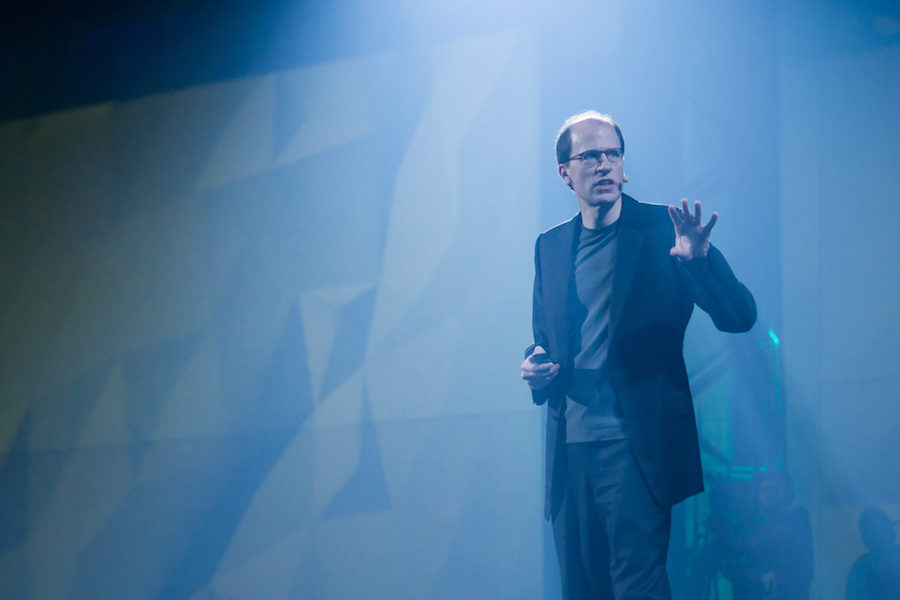
Nick Bostrom. Photo: Allen McEachern
The Swedish philosopher is one of the most influential in the field of superintelligence. He is the director of the Future of Humanity Institute at the University of Oxford.
Transhumanism explores the possibility of improving physical, emotional and cognitive human condition through scientific and technological progress. I speak about this intellectual, scientific and cultural movement with philosopher Nick Bostrom (Sweden, 1973), founder of the World Transhumanist Association together with David Pearce and one of the most influential thinkers in the field of superintelligence. He is also the director of the Future of Humanity Institute and the Governance of Artificial Intelligence Program at the University of Oxford. He is the author of more than 200 publications, "Human Enhancement" and "Superintelligence: Paths, Dangers, Strategies", bestseller of the “New York Times” and strongly recommended by Bill Gates and Elon Musk.
What led you to create the World Transhumanist Association?
Well, it happened in the 90s. At that time, it seemed to me that there was no adequate forum to discuss the impacts of the emergence of future technologies and how they may affect the human condition. Back then, the emphasis was mainly on the negative. Most of the relevant topics were not discussed at all and the few discussions on academic bioethics always focused on the inconveniences, such as possible dehumanization by using technology to enhance human capacities. There needed to be another voice. The association was an attempt to create a platform which fulfills this demand.
And what about today?
I have not been involved for many years. In the early 2000s, these problems found a voice and were developed in the academic field. Thus, the organization was no longer a necessity.
There is talk about artificial intelligence attempting to develop a conscious intelligence in order to learn in the same way humans do. What can you tell us about this?
I think that a lot of the excitement over the last eight years is due to advances in deep learning; which is a particular focus of AI. This way of processing information is, in many ways, similar to how our human mind works. Excitement is created because it seems to be a more "general" way of structuring intelligence, a type of algorithm that has the general ability to learn from data (big data), learn from experience, and build representations from a pattern present in such data that has not been explicitly pre-programmed by humans. This new concept points to Artificial General Intelligence (AGI).
Can you give an example?
The same algorithm that can learn to play one Atari game can learn to play other Atari games. With small modifications, it can learn to play chess, Go, how to recognize cats in images and to recognize speech. Although there are limits to what can be done today, there are indications that we might be reaching the type of mechanism that provides similar flexibility to that of human intelligence, a type of general learning capacity.
Some voices are more skeptical.
If you look at the systems that are used in the industry, they are still a kind of hybrid. In some cases, these modern deep learning systems are specifically used for image and voice recognition, but many other systems employed by companies continue to be mainly expert systems with a domain specific purpose while following the old school model. This contributes to the confusion.
When do you think molecular nanotechnology will exist, making it possible to manufacture tiny machines that could be inserted into our organisms and thus eradicate many diseases and prolong life?
It's a good question... I believe that nanotechnology will probably be viable after the development of artificial superintelligence. The same goes for many other advanced technologies, which could be developed by using superintelligence for research and development. However, there could be a scenario in which molecular nanotechnology is developed before artificial intelligence takes off. In that case, the first applications would present risks that we would have to survive and if we succeed, we would have to survive the risks associated with superintelligence, once it is developed. Therefore, if we were to be able to influence the order of the development of both technologies, the ideal goal would be to obtain superintelligence before molecular nanotechnology.
Another way to prolong life would be through cryonics. More than 300 people have their bodies cryogenically frozen or their brains preserved in nitrogen. You registered for this service, what prompted you to do so?
Actually, in the interactions I have had with the media, I have never confirmed I did. My stance has always been that my funeral arrangements are a private matter. I know there have been speculations in a newspaper two years ago... It is also true that some of my colleagues are cryonics clients, and they have made it public, like Dr. Anders Sandberg, who is one of our researchers here.
With cultural diversity and different moral codes worldwide, how can we reach a global consensus on ethical limits in genetic research?
For the moment, humanity does not really have a single coordinated plan for the future. There are many different countries and groups, each one pursuing its own initiatives.
From what you say, foresight is essential.
If you think about the development of nuclear weapons 70 years ago, it turned out it was hard to make a nuclear bomb. You need highly enriched uranium or plutonium, which are very difficult to get as you would need industrial sized power plants in order to make them. In addition to that, a huge amount of electricity is needed, so much so that you could see it from space. It is a hard process. It is not just something you could do in your garage. However, let us suppose that they had discovered an easy way to unleash the energy of the atom; that might then have been the end of human civilization as it would have been impossible to control.
It is worrying to think.
Yes, it would be in these cases that perhaps humanity would have to take steps to have a greater capacity for global coordination in case such vulnerability arises or a new arms race emerges. The more powerful our technologies are, the greater the amount of damage we can cause if we use them in a hostile or reckless manner. At this point, I think this is a great weakness for humanity and we just hope that the technologies we discover do not lend themselves to easy, destructive applications.
Recent studies have shown that graphene can effectively interact with neurons. What do you think about the advances in the development of brain-machine interfaces (communication zones) that use graphene?
It is something exciting from the point of view of medicine and people with disabilities. For patients with spinal cord damage, it has several promising applications such as the neuro-prosthesis. However, I am slightly skeptical that it enhances the functionality of a healthy person sufficiently to make it worth the risks, pains and problems of a surgical intervention.
Do you think it is not worth it for a healthy person?
It is quite hard to add functionality to a healthy human mind that you could not get, in a similar way, by interacting with a computer outside of your body, simply typing things on a keyboard or receiving inputs through your eyeballs by looking at a screen. We already have high bandwidth input and output channels to the human brain, for instance, through our fingers or through speech. It is much more relevant to find a solution to how to access, organize and process the vast amount of information available with the limitations of the human brain. That is the bottleneck of the problem and it is where the focus of the development should lie.
In your book Superintelligence you comment that the artificial intelligence research project begins at Dartmouth College in 1956. Since then there have been periods of enthusiasm and regression. At present, it seems that the biggest advocate for the creation of a post-human AI is Ray Kurzweil, founder of Singularity University and financed by Google. Do you think they will achieve their objective this time?
I do not think Ray Kurzweil is the leader in research of AI. There is a big global research community with many important people making significant contributions and I do not think he plays a significant part in most of them.
Would such research be aimed at replicating the human brain including consciousness?
Artificial intelligence is mainly about finding ways to make machines solve difficult problems. Whether they do so by emulating, assimilating, or drawing inspiration from the human brain or not, is more of a tactical decision. If there are useful insights that can be extracted from neuroscience, they will be taken advantage of, but the main objective is not to try to replicate the human mind.
I thought a posthuman project already existed…
If you are referring to the Human Brain Project, then yes. It might be a little bit closer to trying to emulate various details and levels of the human condition. I have the impression that it initially began with a very ambitious vision and probably excessive expectations, with very detailed models of a cortical column. However, after several dissonant voices, it has become a funding channel for several neuroscience projects.
You mentioned that with superintelligence (on a human level) we can obtain great results but at the risk of human extinction.
I think superintelligence would be a kind of general-purpose technology, because it would make it possible to invent other technologies. If you are super intelligent, you can do scientific or engineering work much faster and more effectively than human scientists and engineers can. So imagine all the things that humans could achieve if we had 40,000 years to work on them; perhaps we would have space colonies, upgrades in our organism, cures for aging and perfect virtual realities. I think all of these technologies, and others we have not thought of yet, could be developed by machines of superintelligence and perhaps within a relatively short amount of time after its arrival. It gives us an idea of the vast amount of potential benefits.
What would be the “existential risks” we would face with artificial intelligence?
I see two types of threats. The first one arises from a failure to align objectives. You are creating something that would be very intelligent and powerful at the same time. If we are not capable of finding a way to control it, we could give rise to the existence of a super intelligent system that might prioritize attaining its own values to the detriment of ours. The other risk is that humans use this powerful technology in a malicious or irresponsible way, as we have done with many other technologies throughout our history. We use them not only to help each other or for productive purposes, but also to wage wars or to oppress each other. This would be the other big threat with such advanced technology.
Stephen Hawking called for “expansion to space” and Elon Musk’s company Space X expects to send people to Mars in the near future. What do you think are the reasons we will be forced to migrate to other planets? Could humans live on Mars?
At this moment in time, Mars is not a good place to live. A meaningful space colonization will happen after superintelligence. In the short term, it seems very unattractive; it will be easier to create a habitat at the bottom of the sea or on top of the Himalayas than to do it on the Moon or Mars. Until we have exhausted this type of places, it is difficult to see the practical benefit of doing so on Mars. However, in the long term, space is definitely a goal; Earth is a small crumb floating in an almost infinite expanse of resources.
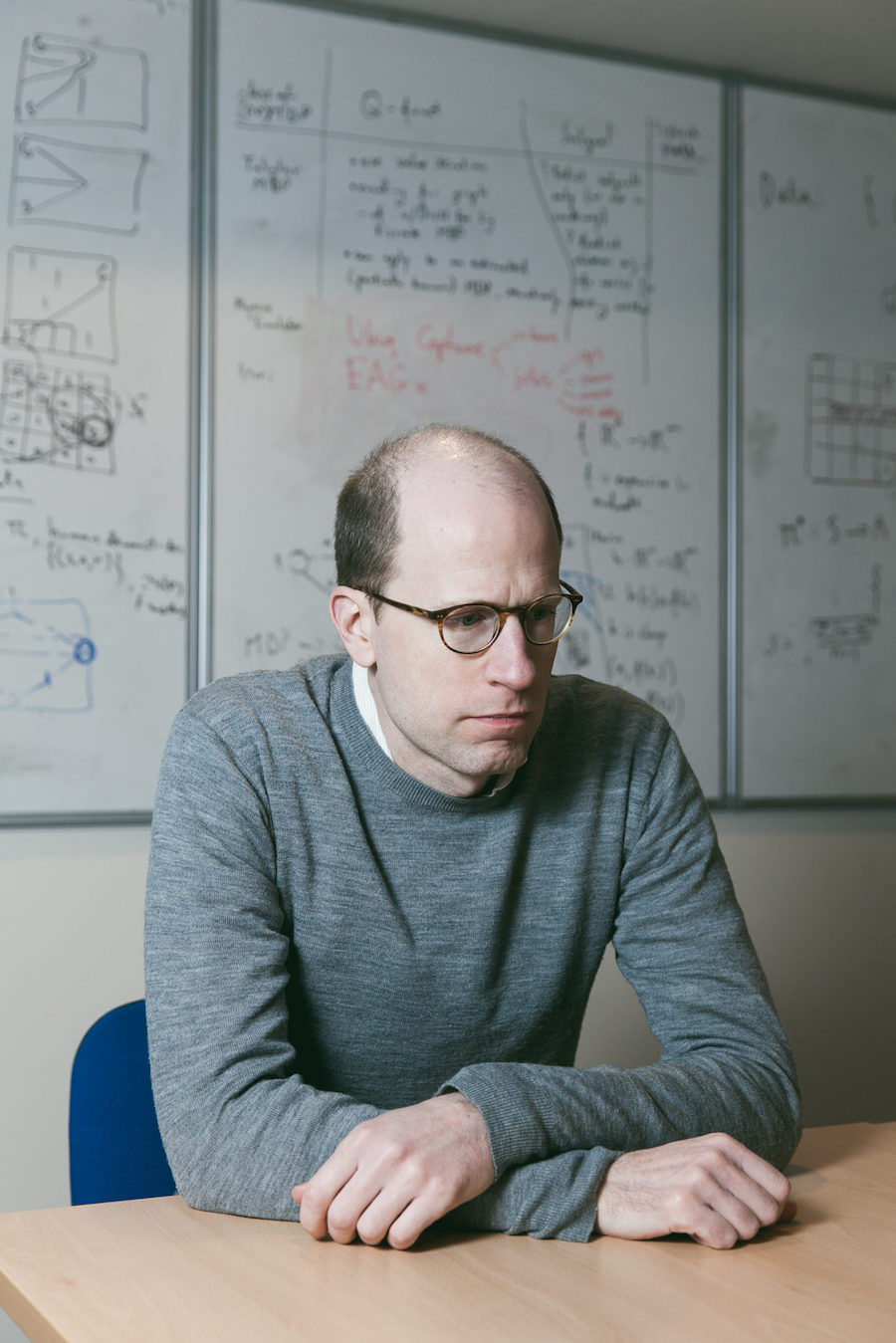
Nick Bostrom
- Details
- Written by Elena Cué
With twilight beginning to fall on the little French village of Barjac, I began my tour of La Ribaute ~ 40 hectares of the German artist Anselm Kiefer's making ~ which would conclude at sunset the following day without me having managed to visit all the towers, over and underground tunnels, crypts in a permanent state of transformation, an amphitheatre and pathways planted with sculptures that make up this extraordinary place, a place that is emotive for its grandeur, for its limitless space and for its eerie mystery.
Author: Elena Cué
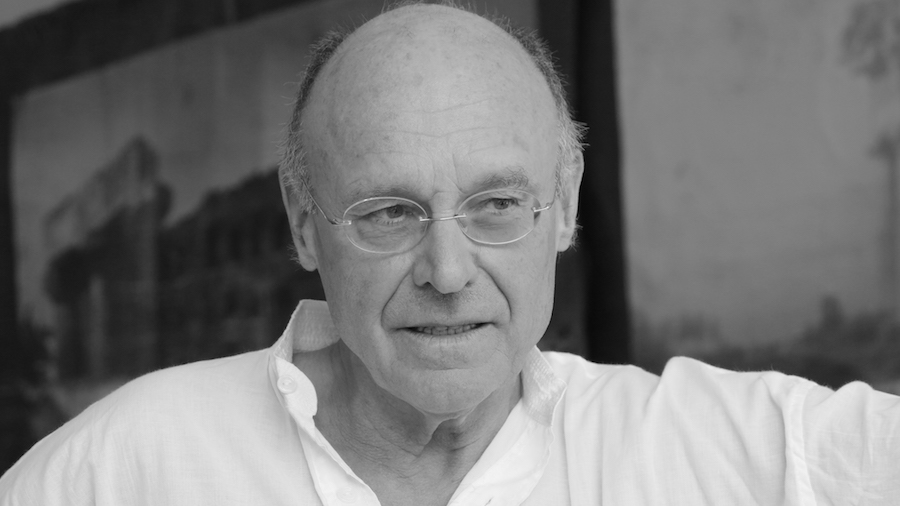
Photograph: Waltraud Forelli
With twilight beginning to fall on the little French village of Barjac, I began my tour of La Ribaute ~ 40 hectares of the German artist Anselm Kiefer's making ~ which would conclude at sunset the following day without me having managed to visit all the towers, over and underground tunnels, crypts in a permanent state of transformation, an amphitheatre and pathways planted with sculptures that make up this extraordinary place, a place that is emotive for its grandeur, for its limitless space and for its eerie mystery.
Anselm Kiefer is one of the most relevant artists of today.
I come back from the amphitheater extremely impressed. In fact, I am overwhelmed by everything. I will need a lot of time to assimilate it all.
The amphitheater developed in the same way a painting does. I had a big wall where all the big paintings are, and I thought, why not have a little grotto inside. So, we made some containers, we put them together to form a niche, we continued one floor after another and it worked just like a drawing, step by step.
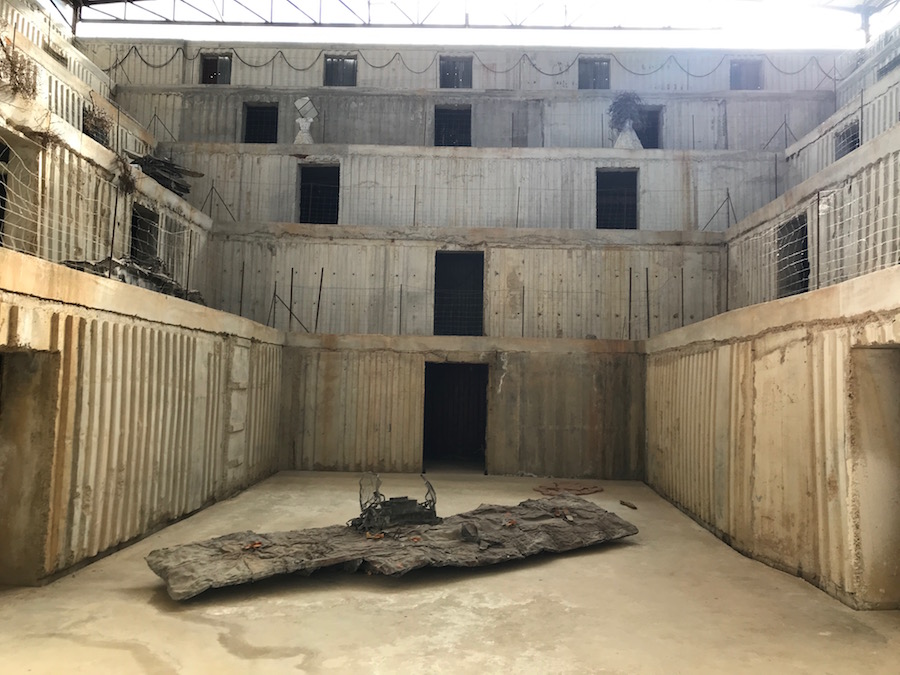
Amphitheatre. Photo: Elena Cué
You were born in 1945 in the twilight of World War II.
I was born in the cellar of a hospital. That is where my mother gave birth to me and that same night our house was bombed.
Your toys were ruins and bricks, which you have gone on to use in your work, both as materials and as concepts. Are you still playing with those ruins?
Ruins are the most beautiful thing and because children do not judge, they just take them and play with them. They are for me not an end but a beginning. Sometimes, I knock down a tower by dismantling a piece just to watch how it falls. It is beautiful to see a tower, from which the keystone has been removed, reflecting if it wants to fall, how it hesitates; then everything goes very quick and with great noise to the ground. The feeling is comparable to that of starting an airplane. Full throttle is engaged. The airplane quivers with the power that wants to bring it forwards while the brakes still hold it in place, the machine, getting faster and faster, finally lifts itself into the sky.
At a time when Germany was spiritually and materially devastated, what were the values you grew up with?
I had a very authoritarian education because my father was an officer. On one side there was the authoritarianism of the Catholic Church and on the other, that of my father who was also my teacher. But my father also showed me the painters that were ostracized during the Third Reich and, in the earliest years of my childhood, lead me to painting and drawing.
You said that building Barjac was something that rebelled in retrospective. First was the experience and then the concept...
If you mean whether my work follows a thought out concept then the answer is: of course. I always have a concept, otherwise I wouldn’t be able to start. However, during the work and over the course of days, weeks or years, the concept changes. The concept is necessary but not important.
What do you feel when you look at La Ribaute?
I feel it is unfinished.
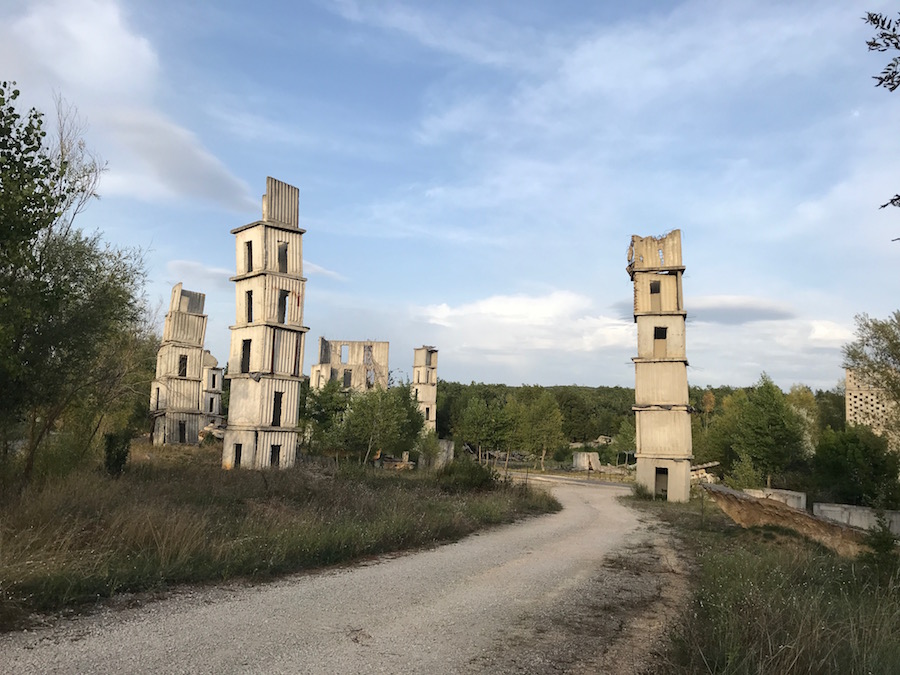
La Ribaute, Barjac. Anselm Kiefer. Photo: Elena Cué
What particular need led you to build something so unique in Barjac?
When I moved to France, my idea was to no longer have assistance from anybody. I didn’t want an office, I wanted to simplify my practice and to do everything on my own. I wanted to make very light paintings that I could roll and take anywhere. I wanted to work by myself, without any assistance. It was like a cultural revolution. Leave everything behind you, stop painting and start over again!
Here architecture, paintings, sculptures, and even music concerts come together. Are you trying to recreate Wagner’s concept of Total Work of Art?
I do not use the word “gesamtkunstwerk”. It has an uncomfortable connotation. I would rather speak of a work in progress. The most important is not the result but the ephemeral, the ever flowing, that which does not come to an end.
In 2011, you designed the scenography for the opera Elektra at the Teatro Real in Madrid. Do you intent to collaborate on another opera?
Yes, when the right piece, and a director with whom I share an aesthetic, come together. Klaus Michael Grüber, with whom I collaborated on Oedipus at Colonus at the Burgtheater in Vienna and Elektra in Naples, was for me a great match. He, unfortunately, passed away during pre-production.
You have said that in your childhood boredom helped you become a philosopher. Do you think that a state of boredom could be really creative?
Boredom is the beginning of philosophy. If you are active, you do not reflect. Heidegger has a lecture series on boredom. He says when you are invited to an event and it is a little bit boring, you become aware of the fact you are. It becomes clear what it is to be.
Which philosophers do you identify with?
Roland Barthes, Johann Gottlieb Fichte, Martin Heidegger, Leibniz, Carl Schmitt, Gustav Radbruch, Feuerbach…
What is it that normally forces you to think and create?
I do not paint because the canvas is empty or because I have nothing else to do. I start painting when I have a shock. When I am overwhelmed by something that moves me, something that is greater than me. It can be a real experience with a person, a landscape, a music piece or with a poem. Critics say that I aim to overwhelm but in reality, I am the one who is constantly overwhelmed. That is what happens when I start to work. If you are not feeling overwhelmed, why are you alive? We are here to be overwhelmed otherwise, there is no reason to be.
Where does your inspiration come from?
If you ask writers, they will tell you that all the material they have comes from their childhood. The same is true for me.
You said that you have always been drawn to the impossible. How many times have you tried to achieve the impossible?
You cannot achieve the impossible. You can only dream of it and try it. The word achievement is difficult because it is always a process. I could never say something is an achievement; it is only in our heads.
Your work is full of mythological references from Germany, Ancient Greece, Ancient Egypt and Kábbalah, among others. Have you found an element of unity between them?
Yes, all mythology is connected. For example, the Norse legend of Wayland the Smith, who was captured by the king and could not escape. That same legend exists in Egypt and Northern Germany. You can find connections in all of mythology.
You have been labeled as one of the biggest representatives of neo-expressionism. What does this artistic style provide that others do not?
I am fundamentally against style.
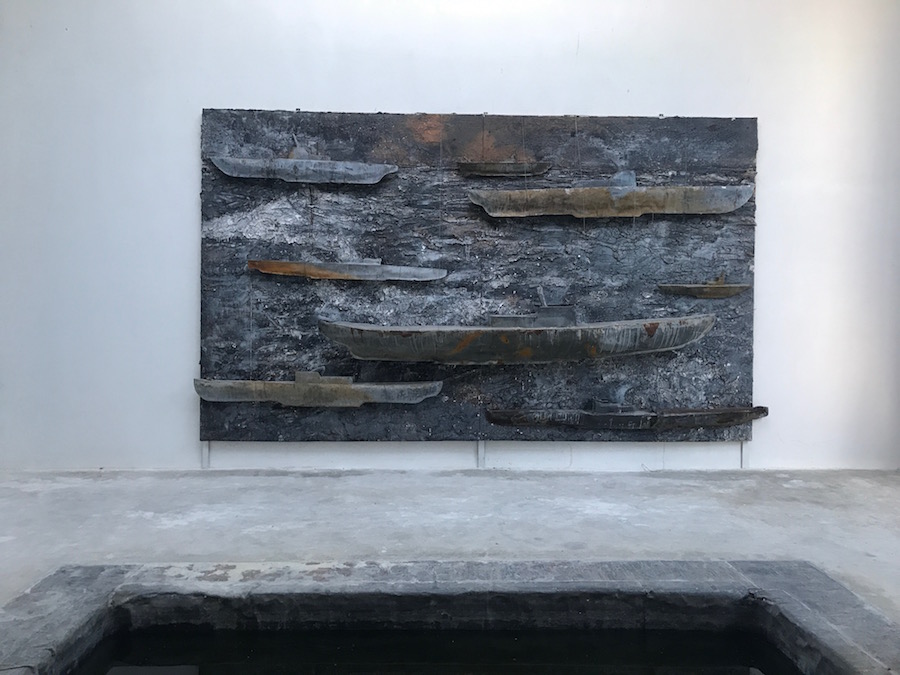
La Ribaute. Barjac. Anselm Kiefer. Photo: Elena Cué
What motivated you to include figurative objects such as submarines, sunflowers, tulips, etc, in your work? Why did you begin to combine painting and sculpture?
It is a question of reality. When I introduce an object, I do not create any additional illusion. What I make is what it is. Sometimes I want to be direct. Objects have their own spirituality.
Why did you choose painting instead of writing?
I cannot say that it was a conscious decision. It came to me this way. Throughout my career I have always had moments when I thought about writing a book. I have a lot of book concepts in my diary but I cannot say I have decided on one.
Then, is it a balance between writing and painting?
Yes, but it is not writing, it is rather experimenting with oneself. I do not write fiction or poetry. Poetry is something different; you arrange the words in a certain combination that has never been seen before.
What about painting?
It is recreation as well.
Do you reflect yourself better through painting than through writing?
Writing helps us analyze what we have done. Besides, it is a form of self-assessment.
Do you ask yourself if you are satisfied?
All the time.
How do you feel when you read your own work?
My writings are for me a way to remember. The new arises from memory.
And when you look at your paintings in retrospect?
Exactly like Paul Valery, sometimes I think they are marvelous, at other times they make me feel desperate.
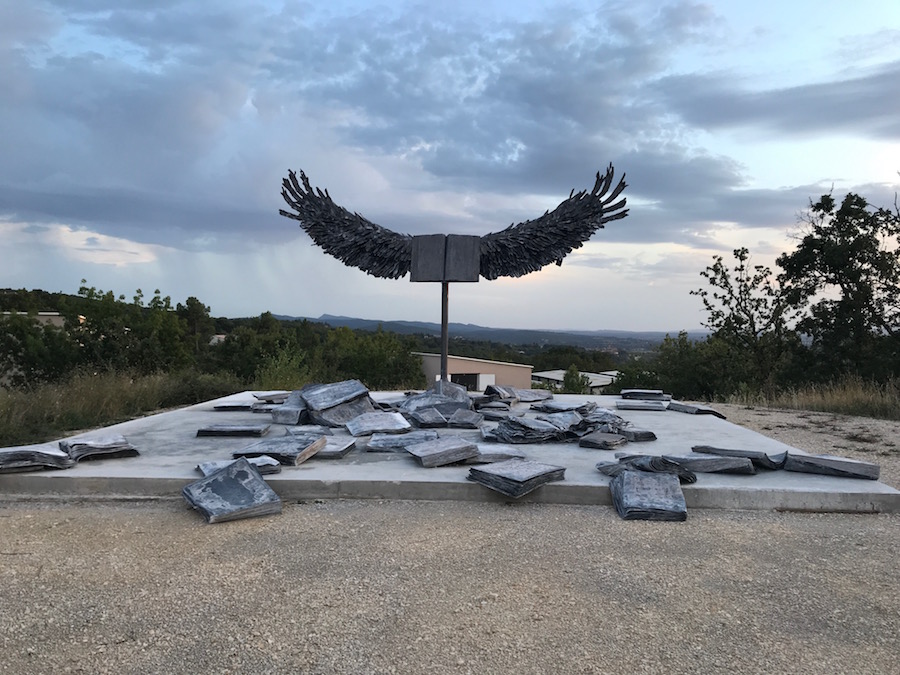
La Ribaute. Barjac. Anselm Kiefer. Photo: Elena Cué
You have said that art is closest to the truth. Could you explain this concept?
Art is even closer to the truth. It is truth.
Do you think that through art you are able to express who you really are?
I am not important. I am sometimes me and then many others.
The Holocaust is very significant in your work. It is depicted through a wide range of symbolism. What is your objective with the representation of the darkest moment in your country’s history?
When I was growing up, the Holocaust did not exist. No one spoke about it in the 60s. I felt that there was something hidden. By accident, I got a disc with the voices of Hitler, Goebbels and Goering. It was made by Americans in order to educate Germans. I was so fascinated by Hitler that I began to study. I wanted to know what it was all about.
Was it necessity or curiosity that prompted you to investigate it further?
It was curiosity. When you begin to study what happened during those times it is so horrible that it is hard to imagine. Only in 1975 in Germany did they finally start showing exactly what had happened during the Holocaust. Ever since then the Germans have been quite good at revealing it. The French are still hiding a lot of it. At the time, Austrians wanted no relation with anything German. An Austrian journalist complained to me that I put Austrians and Germans in the same category. Back then Hitler was surprised as he thought he would have to fight Austria in order get an unification. It turned out they all wanted it already. They were even more efficient and accurate with their Jewish lists than the Germans. The French forcefully sent about 100,000 people to work in the German weapon industry. I never believed that there was a point zero. Democracy was first brought by the Americans.
During the keynote address of your lecture series at the Collège de France, you said that you learned most about art through reading The Thief's Journal by Jean Genet. Could you explain why?
I was so overwhelmed by his writing. He literally turned everything upside down. He would take the most honorable thing you could do and stick it deep in the swamp, whilst the most horrible thing, for example, to kill someone, he considered a piece of art. He turned everything upside down and this was fantastic to me.
You said: “The alchemy of transforming the abject into art is the true magic”. Why are you so attracted to alchemy?
Alchemy is the first step to science, chemistry and physics. It is the teaching of transmutation. It is also a spiritual movement. People always say that alchemists try to turn lead into gold but the real alchemists do not want to do that. It is a picture to transform yourself on another level. Alchemists are the first natural scientists.
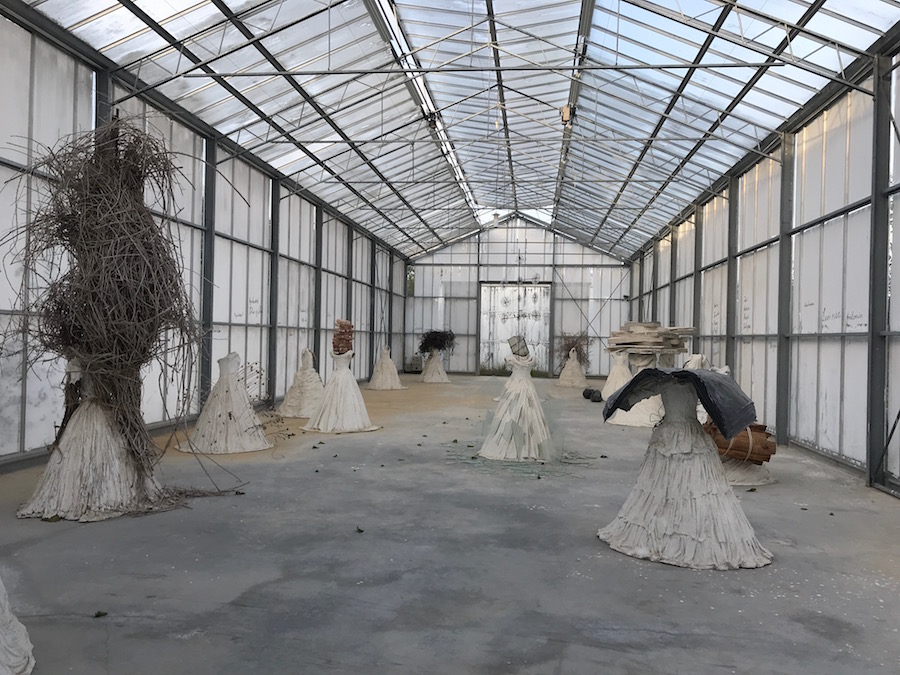
La Ribaute. Barjac. Anselm Kiefer. Photo: Elena Cué
You were photographed dressed as a woman for the work Jean Genet. You depicted women in Les Femmes de la Révolution, Les Reines de France, Les Femmes de L'Antiquitié, en Margarethe y Shulamith. What do women represent in your work?
I am always overwhelmed by women and I think they are more connected with the roots of earth. They are more powerful than men.
You say that art should be subversive and disturbing. What do you think about the relationship between art and society?
I am going to refer to Jean Genet again. He is subversive because he preaches that stealing and killing are the best things; that you have to become a traitor. Art can never be moralistic. Art cannot be a judgement of society because morals are connected to the times. Let us go back to the times of Greek democracy. In those days you could have slaves. Even Aristotle said that in order to be a good philosopher you have to be rich and have slaves. It is all connected with certain times. Artists should not be connected with a specific moral behavior.
You have spoken extensively about the artist being a destroyer and a creator. It is key in your work. Could you elaborate on this concept?
The artist is an iconoclast, he or she destroys all the time. There is art and anti-art. If the artist is not an iconoclast then he is not really an artist. You can see it through the history of art. I destroy what I do all the time. Then I put the destroyed parts in containers and wait for the resurrection.
The idea of infinity is implicit in your work and provokes a sense of the sublime. Do you intend to do so?
Eichendorff in his poem, sends his soul out in the world and then it comes back to him. It is a never-ending circle. I follow the philosophical system which includes emotion, will and reflection. Eichendorff describes a globe as a sphere; a kind of a sphere that gives immunity. Before you are born, you share a sphere with your mother, you are connected in the womb. This is the first sphere. Then the sphere gets wider as you meet more and more people. The romantic sphere is endless. It goes to the infinite and comes back.
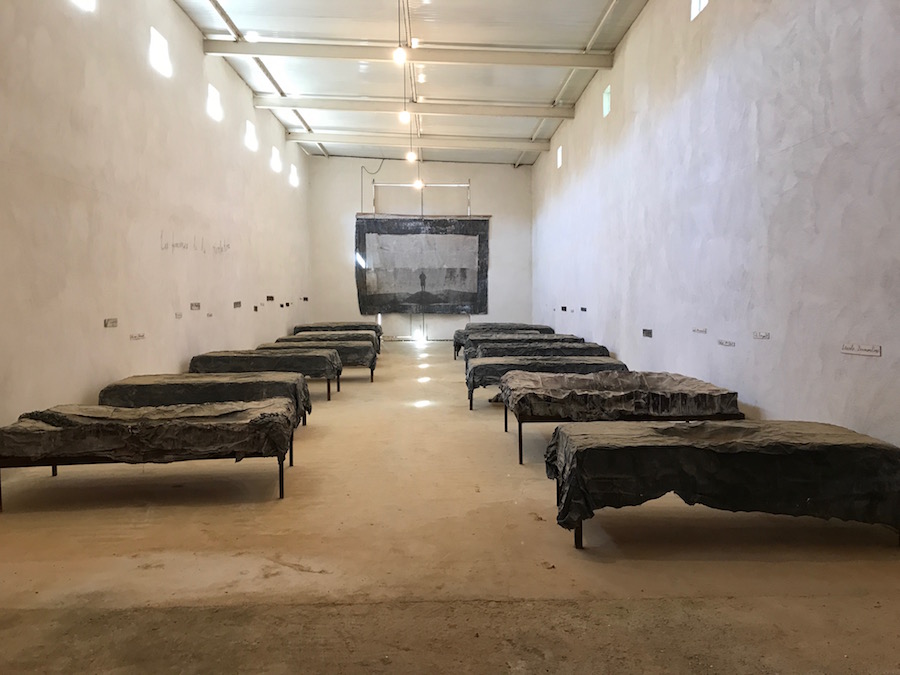
The Women Of The Revolution. Anselm Kiefer. Photo: Elena Cué
The landscape with your figure in the middle of the Les Femmes de la Révolution room reminds me of Friedrich's landscape and the concept of the sublime. Do you look for the sublime?
It is not really my world. Who invented the word sublime?
The first to use that term was a Greek from the Hellenistic era, but it became popular at the beginning of our time, and among others Kant who wrote a book about the beauty and the sublime.
There is a wonderful quote by Kant: “Two things fill the mind with ever new and increasing admiration and awe, the more often and steadily we reflect upon them: the starry heavens above me and the moral law within me.”
Are there things that have come to the surface through your work that you would have preferred to keep hidden?
No. There is so much that is hidden. You can reveal as much as you want and still never get to the center.
What is your opinion of the first Documenta and Nazi Degenerate art.
I looked through all the Nazi paintings and architecture and did not find a decent painting. I studied them all. I thought that there might be something hidden but they were all nonsense. However, architecture was different. It was not Nazi architecture per se, it was the architecture of the time because it was connected to tradition. You can see the same type of architecture in Paris and Rome. People wrongfully view that type of architecture as Nazi. For example, they say architecture should not overwhelm people. But why not? We are overwhelmed all the time, look at the stars, for instance. An architect must show this. I like Karl Marx Allee in Berlin.
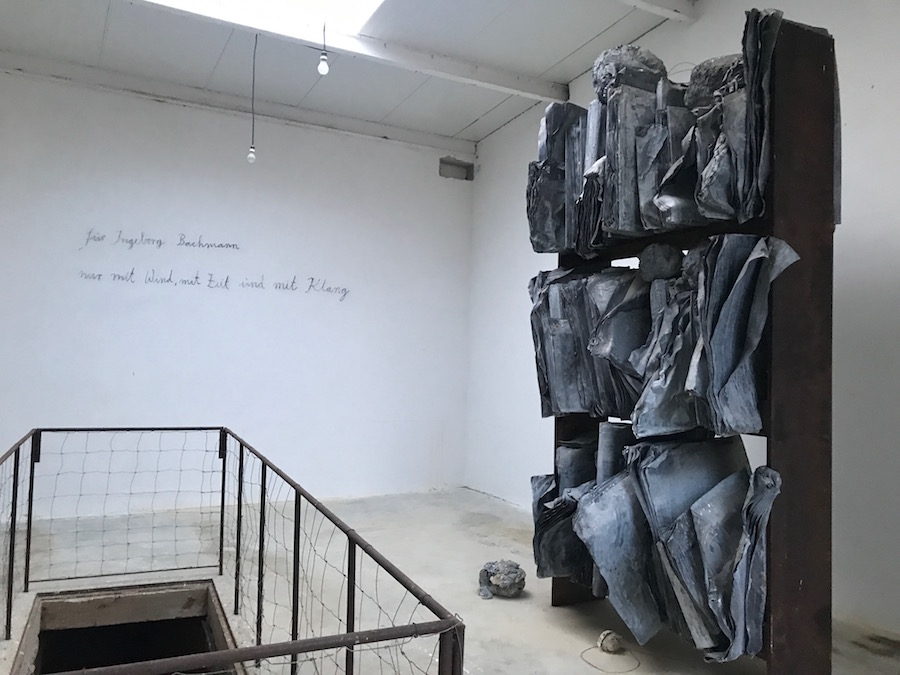
Library. Anselm Kiefer. Photo: Elena Cué
What is your relationship to books? What significance do books have in your life and work?
Books I have made represent sixty percent of my work. I still have most of my earlier books as they were never really for sale.
And in relation to painting?
A painting is different from a book because you can stand in front of it and see an impression of something. When reading a book, you turn the pages; it is connected to time. I like to write books because I can show the process. When I do a painting, I always have a war in my head. At each stage of the painting I have a hundred different possibilities to choose from. For instance, when Picasso was stuck during the creative process he used to tell his wife, Francoise Gilot, to copy his painting so he can come up with a different outcome. When you are painting you always have to make decisions. As you make a choice to go a certain way, you give up a hundred other possibilities.
Always Unfinished - Anselm Kiefer in L.A. - Courtesy of Rick Meghiddo
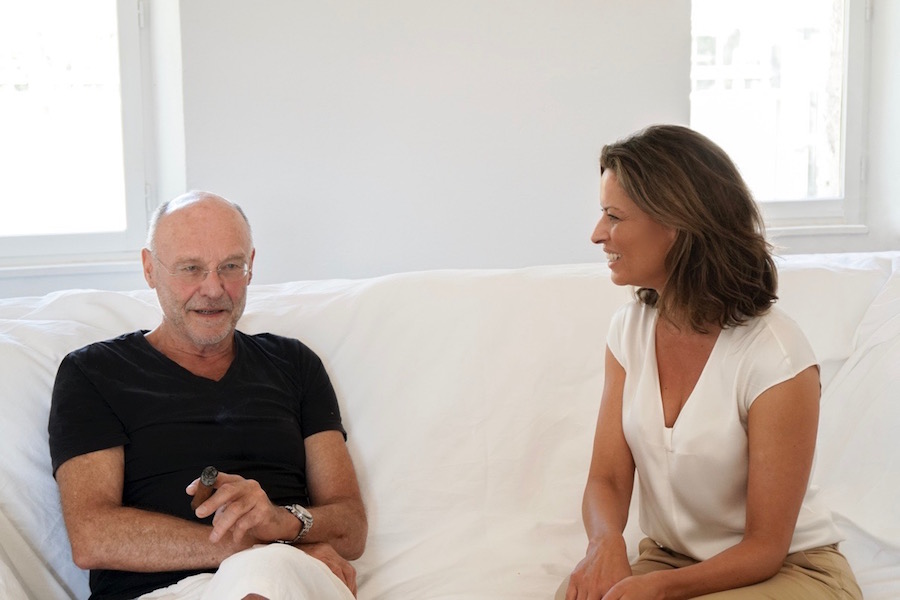
Anselm Kiefer with Elena Cué. Photo: Waltraud Forelli
(Introduction translated from the Spanish by Shauna Devlin)
- Details
- Written by Marina Valcárcel
Coliseum director Dr Rosella Rea accompanies ABC Cultural on an exceptional visit through some of the recently restored, but as yet unopen to the public, areas of this prodigious monument . Back in Madrid, we consult with Pritzker prize-winning Spanish architect Rafael Moneo. “You need to close your eyes to imagine this gallery ... Archaeologists have found coloured, stuccoed areas and many frescoes. We know now that the interior of the Coliseum was red. Only the exterior was light, the colour of limestone travertine. Ancient architecture was always painted in bright colours and to forget this is to veer from reality", says Dr Rea, as we walk through a gallery whose restoration began in 2012 - thanks to a €25 million funding grant from luxury brand Tod's – and, although now completed, is still absolutely out of bounds to the public.
|
Author: Marina Valcárcel
Art Historian
|
 |
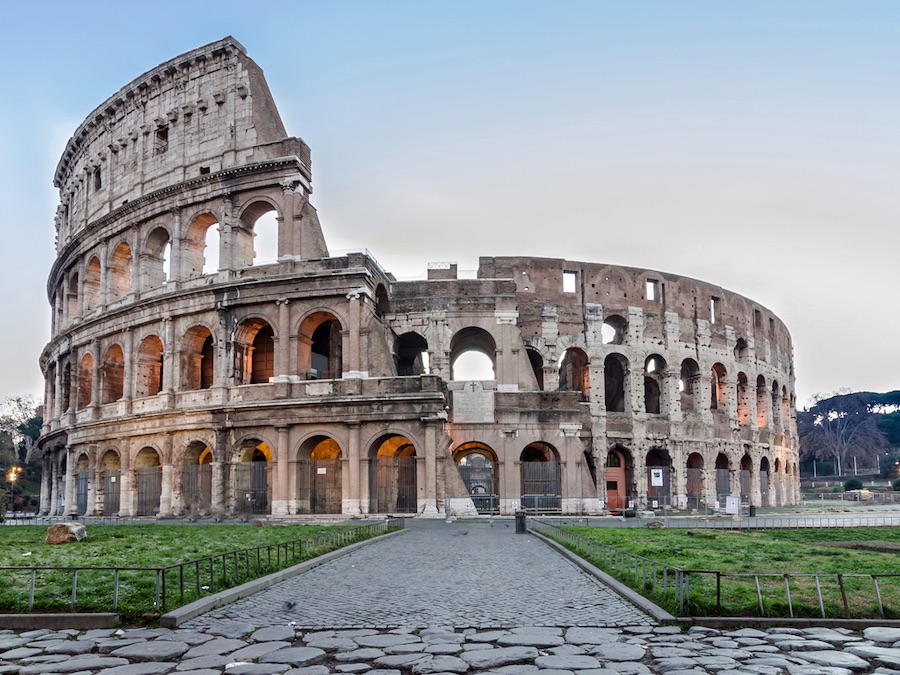
The Colosseum's Archaeological director Dr Rosella Rea accompanies ABC Cultural on an exceptional visit through some of the recently restored, but as yet unopen to the public, areas of this prodigious monument. Back in Madrid, we consult with the Spanish architect Rafael Moneo.
“You need to close your eyes to imagine this gallery ... Archaeologists have found coloured, stuccoed areas and many, many frescoes. We know now that the interior of the Colosseum was red. Only the exterior was light, the colour of limestone travertine. Ancient architecture was always painted in bright colours and to forget this is to ignore reality", says Dr Rea, as we walk through a gallery whose restoration began in 2012 - thanks to a €25 million funding grant from luxury brand Tod's – and, although now completed, is still absolutely out of bounds to the public. "We are in the highest reaches of the building, in an intermediate gallery that connects the third tier with the fourth and fifth. It was meant for the commoner. It is the only covered gallery preserved in its original state, with its frescoes, graffiti and ancient inscriptions."
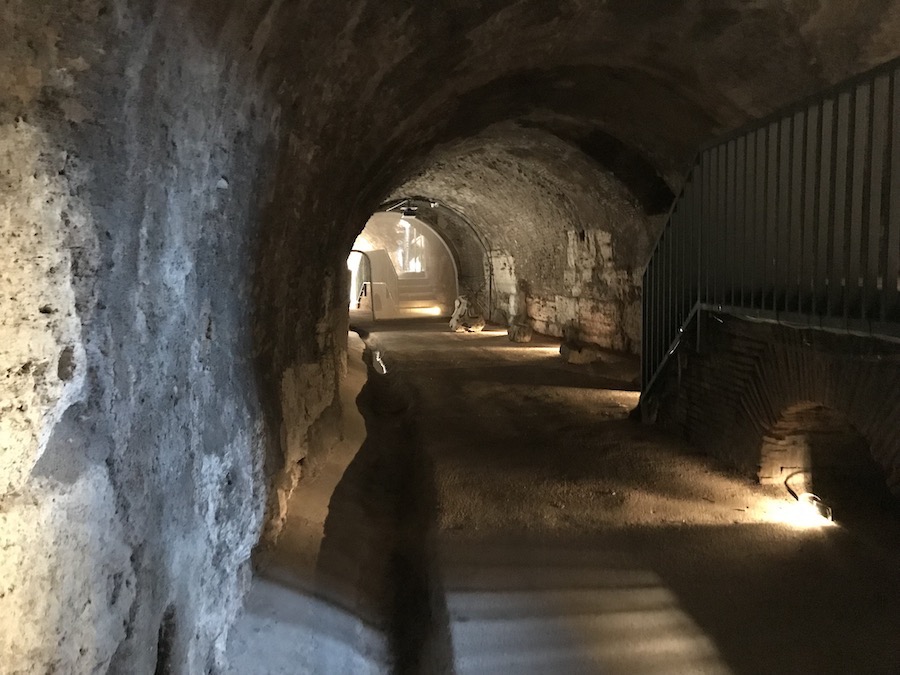
Intermediate gallery connecting the third tier with the fourth and fifth. Colosseum (Rome). Photo: Marina Valcárcel
In this low-ceilinged, curved, narrow gallery the crowds would throng between lit torches or small windows of daylight, with shouting and screaming and the smell of food, dirt and latrines injecting the pure adrenaline of blood and death into the 100-day spectacle of festivals inaugurated by the Emperor Titus in 82 A.D. in his new Colosseum of Rome.
Robert Hughes insists we abandon the virtual images of TV series and video games portraying an "all-white Rome": white marble, white columns, men dressed in white togas looking very grave. "The real Rome was actually the Calcutta of the Mediterranean: crowded, chaotic and filthy," he writes in his book “Rome”.
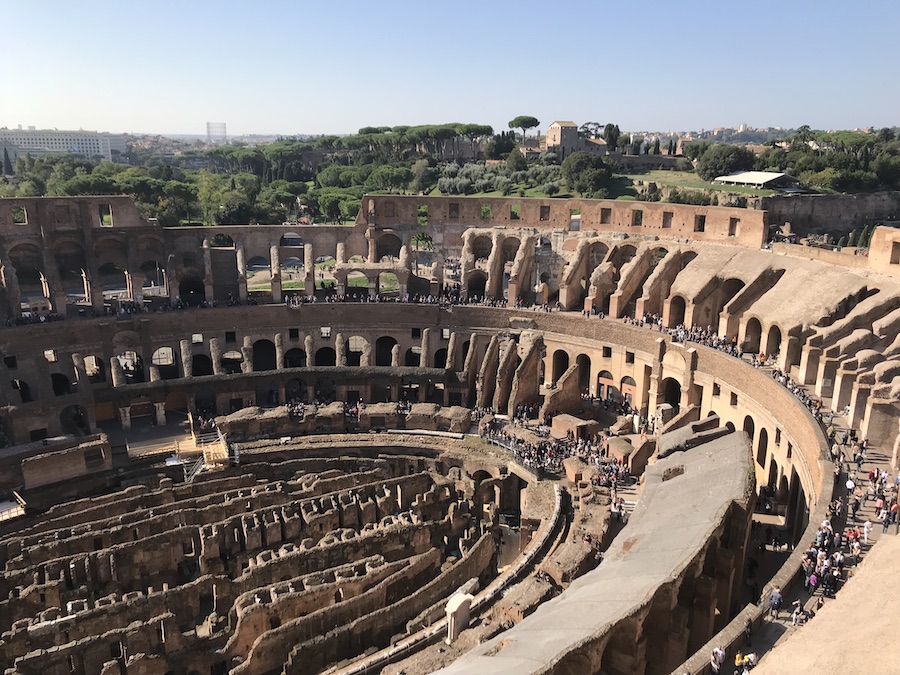
View from the fourth tier. Photo: Marina Valcárcel
From this vantage point you have, by virtue of its height, the most impressive view of the Colosseum. We have a bird’s eye view of the huge skeleton of this stone beast with its open channels, its ribs of subterranean passageways, its arches jutting into the sky, the dark empty eyes of its vomitoriums, the rough skin of its concrete and its dark travertine covered in black scars, a wasp’s nest of square-shaped holes where metal clamps used to hold the stone blocks together before they were ultimately torn out and melted down.
From up here the Colosseum comes back to life in all its old colour, power and glory as it returns to the 1st century and 50,000 spectators enter the stands. Eighty arched entrances topped with 150 bronze statues and 40 golden shields at the attic level commemorate military conquests; senators and magistrates sit nearest to the arena, the commoner man on wooden benches in the top tier and the women and slaves in the "gods"; the roar of the amphitheatre becomes deafening, the grandstand is festooned again with marble and garlands of flowers. Above the windows of the highest level, the decorated beams hold the velarium that unfolds, manoeuvred by a special unit of sailors from the Miseno fleet to cover the amphitheatre with tarpaulin sails that protect spectators from the sun and shower them with water, steam, perfume and rose petals. The emperor, his family, the Vestal Virgins and the Roman priestesses sit on the podium while, through the Porta Triumphalis, the entourage of gladiators, musicians and hunters makes its entrance; opposite, through the Porta Libitinaria, their mutilated bodies will exit the arena ...
The words of the Dr Rea make perfect sense: "What impresses the visitor is not so much the visit itself as the fact of being here and living this experience."
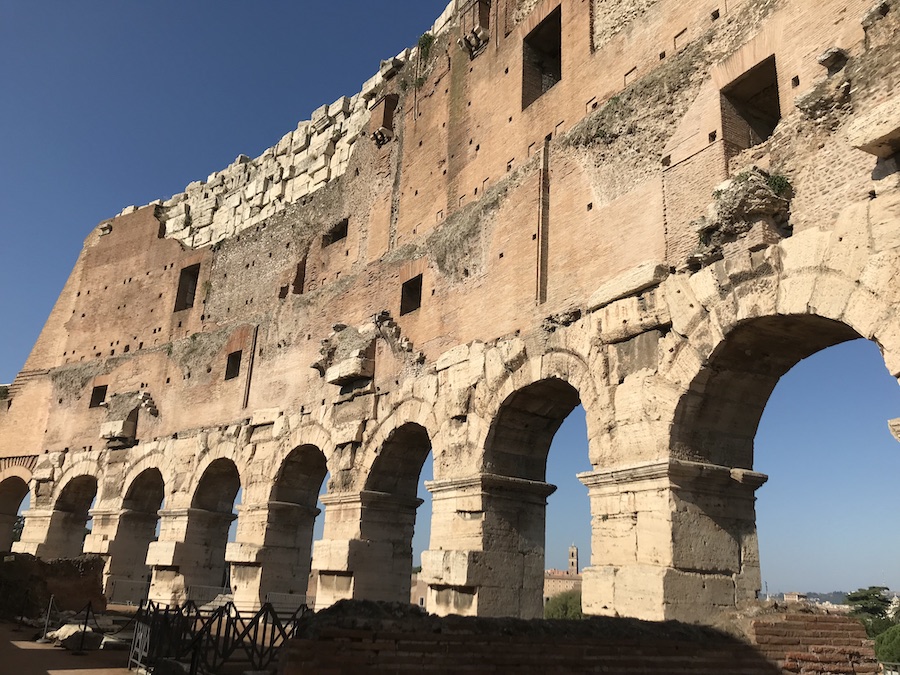
View from the fifth tier and the buttress. Photo: Marina Valcárcel
So how are we to understand the secret to this feat of architectural engineering? The Flavio Amphitheatre, completed in the year 80 AD, reaches a total height of 52 metres; the major axis measures 188 metres and the smallest 156 metres. The total area covered by sand is 3,357 square meters. The Romans used slave labour, without which many of Antiquity's megalithic constructions, from the Egyptians to the Assyrian empire and Rome itself, would not have been viable. But how was it possible to build a monument capable of accommodating 73,000 people in eight years and without mechanical compactors, rotary mixers or any of today's motorized tools? Who invented the system of ramps and passageways that allowed the ingress and egress of the public in just 15 minutes? This system of mathematical accuracy is one that endures today in most of the football stadiums of the world and, of course, in all the bullrings that dot the geography of Spain in small amphitheatres. The Romans took so much from Greek art that they are sometimes considered mere continuators. As regards art, however, as important as the one who creates it is the one who passes it on. The Romans did indeed absorb Greek architecture and sculpture but they also endowed it with the gift of utility, multiplying it in terms of engineering and technical capabilities and, above all, political capacity. Roman art is understood better than ever from this high point of the Colosseum and it is an indescribable propaganda machine of imperial power. And the machinery’s cogs were activated by two generating factors - innovation in architectural materials and the very nature of the shows themselves.
Unrepeatable arquitecture
"The Colosseum, the Pantheon and even some Gothic cathedrals are examples of our architectural past that no modern architect would dare to build today. In the same way it would be difficult to reproduce the tempering of some Renaissance swords today, even though modern steel has great properties," Rafael Moneo points out in our conversation about the Colosseum back in his Madrid studio. "Roman architecture, and the Colosseum in particular, has that complete strength of definition that at times demands an architecture with a resounding constitution and huge dimensions. In this respect, the Colosseum, unlike the Pantheon, simultaneously resolves something very beautifully: the problem of form and use. It is an architecture that comes from Greek theatre; Greek theatres not Greek temples, because it’s understood that the problems of form are linked almost directly to the use that things are put to. In the case of the Colosseum it goes further still, with that slightly oval-shaped level, those specific measurements and that double focus of the ellipse set against the stricter, tougher condition of the circle", adds Moneo.

Interior view of the Colosseum, access gallery to the stands. Photo: Marina Valcárcel
Roman architecture was first and foremost practical. It fulfilled its propaganda function - to spread mini Romes throughout the empire - with military rigour. They would all have their forum, their basilica, their aqueduct, their amphitheatre... "The history of civilization is not understood without Rome, without the empire and without the Church. All of that has become architecture. Culture is deposited in architecture and that is the lesson of that city," concludes Moneo.
To this end, Rome relied on two revolutionary discoveries: concrete and the spread of brick. Greek architecture was based on the straight line: pillars and straight lintels. The genius of Roman architecture was that it built curved structures. This could not be done, at least not on any magnitude, in carved stone. A plastic, malleable substance was needed, and the Romans found it in concrete. With it they erected aqueducts, arches, domes and roads. It was the material of power and discipline. It was strong and inexpensive, allowing very large structures to be built. And size had a special appeal to the Romans when it came to building their empire. But also, with the production of bricks, the Romans came to generate a material at an almost pre-industrial level. Each colony of the empire had its brick factory, each with its own local peculiarity. "It was like amphorae in that each city had its own typology: those of Bética were big-bellied and narrow-mouthed, and so the oil that arrived from Andalusia was distinguishable from the rest that arrived at the port of Ostia from elsewhere in the empire", explains Dr. Rea.
No known author
It is not known who the architect of the Colosseum was. We can only imagine him through Alma Tadema's painting in which he is depicted as a mature, thoughtful man stroking his chin with his left hand while drawing a rough sketch of a very large building in the sand with his right. It is as if the Dutch painter had wanted to honour Architecture through the drawing that this imagined artist presented to Vespasian and which would seem to hold all later architecture within it: from St. Petersburg to the Capitol in Washington; from one magnificence to another.
"The overlapping of classical styles on the facade of the Colosseum became an inspiration for the constructive art of the Renaissance. All later palaces have their origins here," concludes Dr. Rea.
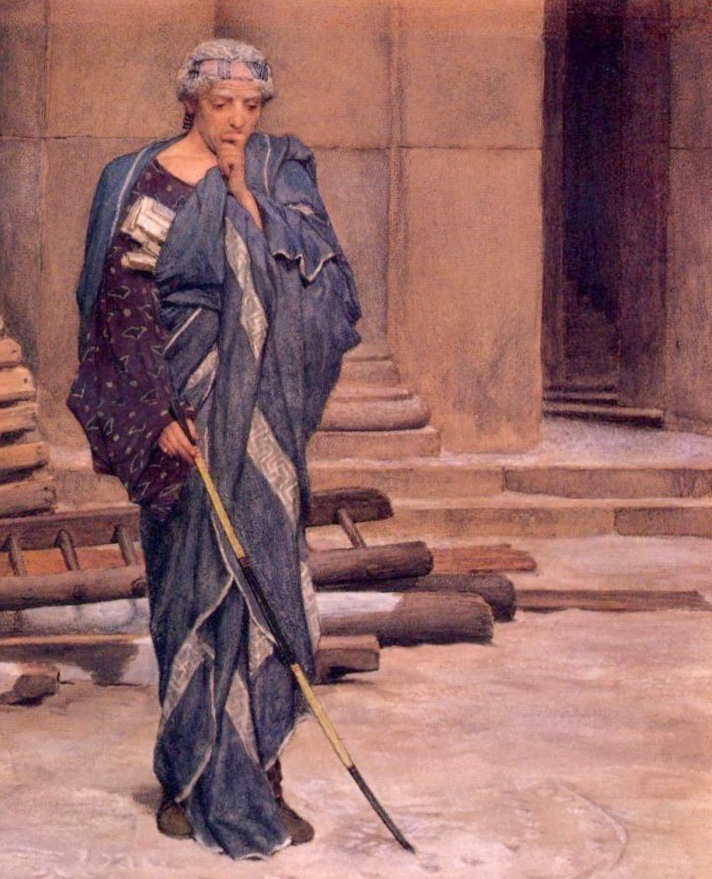
"The architect of the Coliseum", Lawrence Alma-Tadema (1836-1912)
Subterranean Hell
Barbara Nazzaro, the Colosseum's Technical Director, now joins Dr. Rea and both suggest we end this visit with a "descent into hell". The basements, about six meters down, are a humid-smelling web of blackened stone tunnels with water underfoot and here we recall the dark legend of the Emperor Nero whose spectre seems to inhabit these dungeons. Nero had the artificial pool of his Domus Aurea built here in the Colosseum's valley. His suicide in 68 AD and posthumous damnatio memoriae - a kind of historical anti-memory law - only served to bury the imperial residence but the emperor ended up giving his name to the beast. Colosseum does not mean 'gigantic building' but 'place of a statue', in this case of him, 35 metres high and cast in bronze that presided over the esplanade of that folly of extravagance that was Nero's residence.
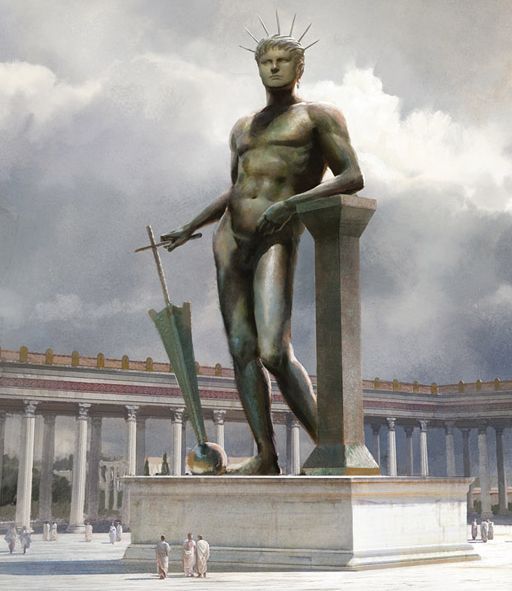
Artist's impression of the bronze statue of Nero for the esplanade of the Domus Aurea
The basement was the secret machinery powering the spectacles taking place above in homage to the glory of the emperor: full-scale re-enactments and performances with lavish scenery, artificial forests and special effects. They housed everything from the dock where the ships anchored for mock seafights to the hunting extravaganzas. Exotic animals dazzled the crowds awed by the greatness of their empire: lions, panthers, leopards, tigers and elephants brought from Africa; wild boars, bears and deer from Germany. From the tunnels crammed with cages and by means of freight elevators, the beasts ascended to the arena in a matter of minutes. Down in this labyrinth, the stench of animals mixed with the smell of slaves and smoke from the torches. Metal supports and beams that reinforced the service lifts were operated by a system of winches operated by slaves. At first there were 28 elevators. "We are talking here about it taking more than 200 people to get them up and running," says Dr Rea. Later, 32 more lifts were built. Trapdoors would be raised for the animals to enter the arena. About one million wild animals were killed in the Colosseum during the time it served as a place of entertainment for the masses, according to Dion Casio. The different plants that grow today between the stones of the Colosseum ruins constitute a legacy from these animals. They were the ones who brought the seeds from distant lands, populating the Colosseum with plant species left in peace to bloom throughout the building.
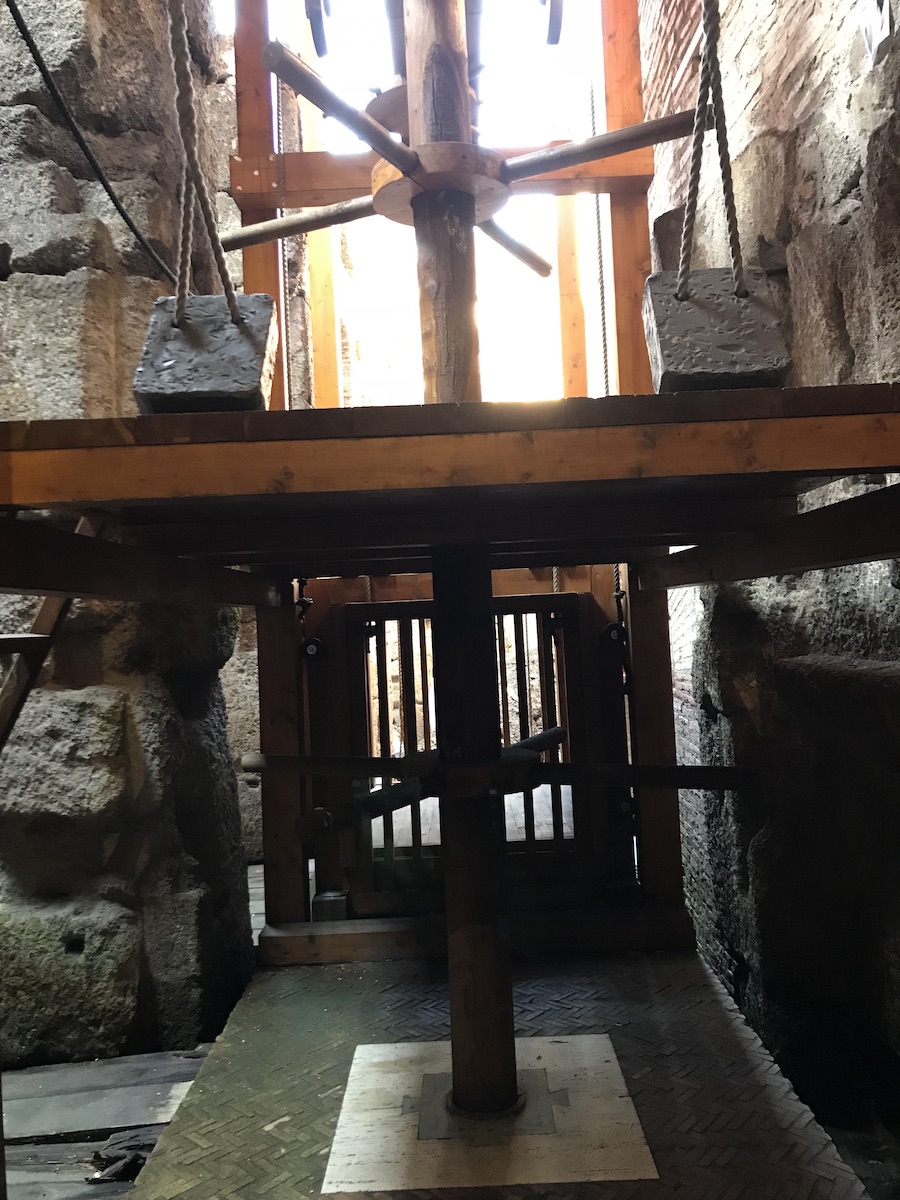
Replica of one of the lifts from the basements of the Colosseum. Photo: Marina Valcárcel
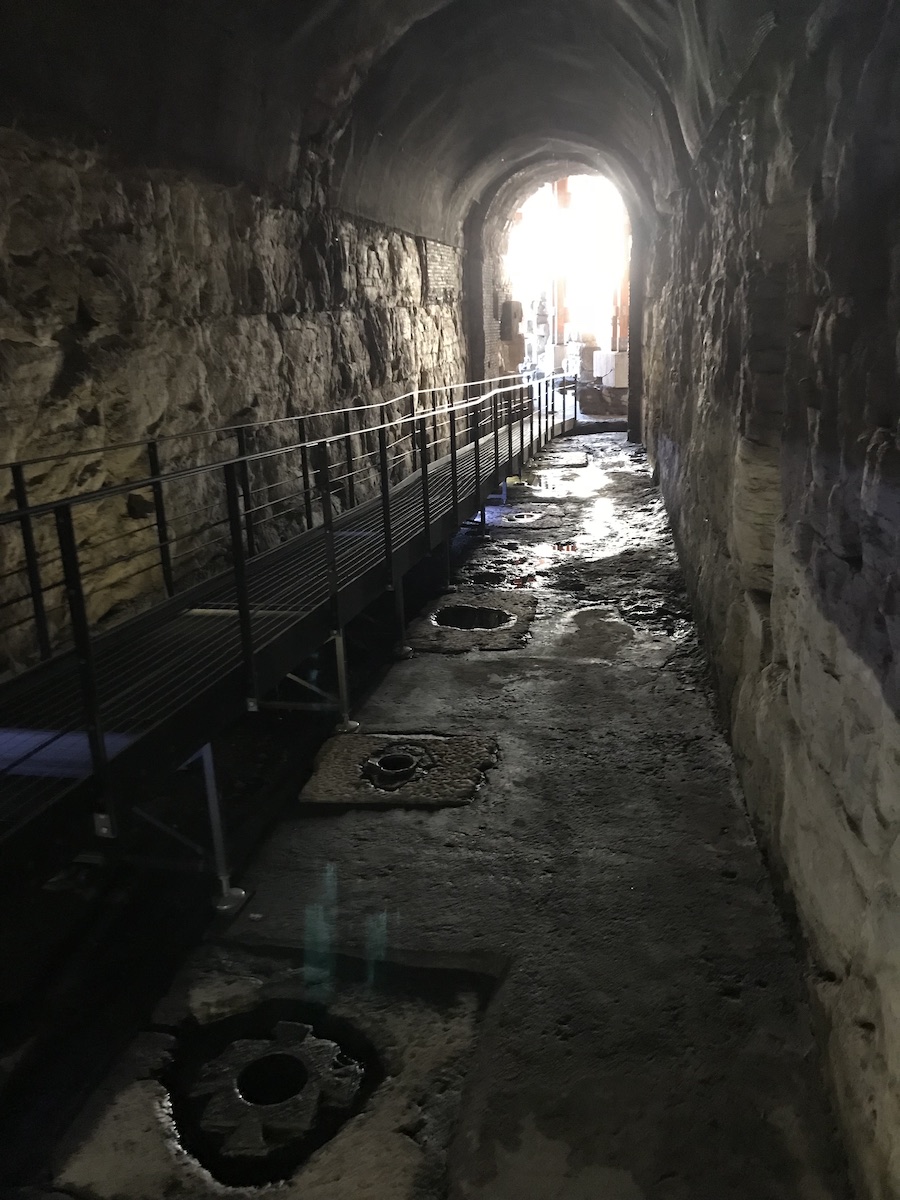
Dock in the interior of the Colosseum. Photo: Marina Valcárcel
From the first centuries after Antiquity and during the Middle Ages, the amphitheatre belonged somewhat to whoever appropriated it: monks from nearby country and vineyard monasteries settled there, as did aristocratic families - like the Frangipani - who fortified it, ordinary people who made it their refuge, their business, their home in which they ate, slept and cooked. The Colosseum is unlike any other known building typology: it is not a temple, nor a palace, nor a church. As the centuries passed, this indeterminacy took on myriad contours: it would serve as a quarry for the construction of other churches - the travertine of its facade would become the stairs of St. Peter's in Vatican City, it would be filled with aedicules for the Via Crucis and it would be incorporated into the architectural projects of Bernini and Fontana who dreamed of building churches out of its sand and bringing its stories of martyrdom back to life.
“Quamdiu stat Colysaeus stat et Roma, quando cadet Colysaeum cadet et Roma, quando cadet et Roma cadet et mundus” ("As long as the Colossus stands, so shall Rome; when the Colossus falls, Rome shall fall; when Rome falls, so falls the world."). This epigram, attributed to the Venerable Bede (672-735), would now seem to have been a prophecy endowing the monument with a fundamental responsibility and centering it as a testimony to the survival of history, as the mirror of Rome and, in turn, the mirror of the world.
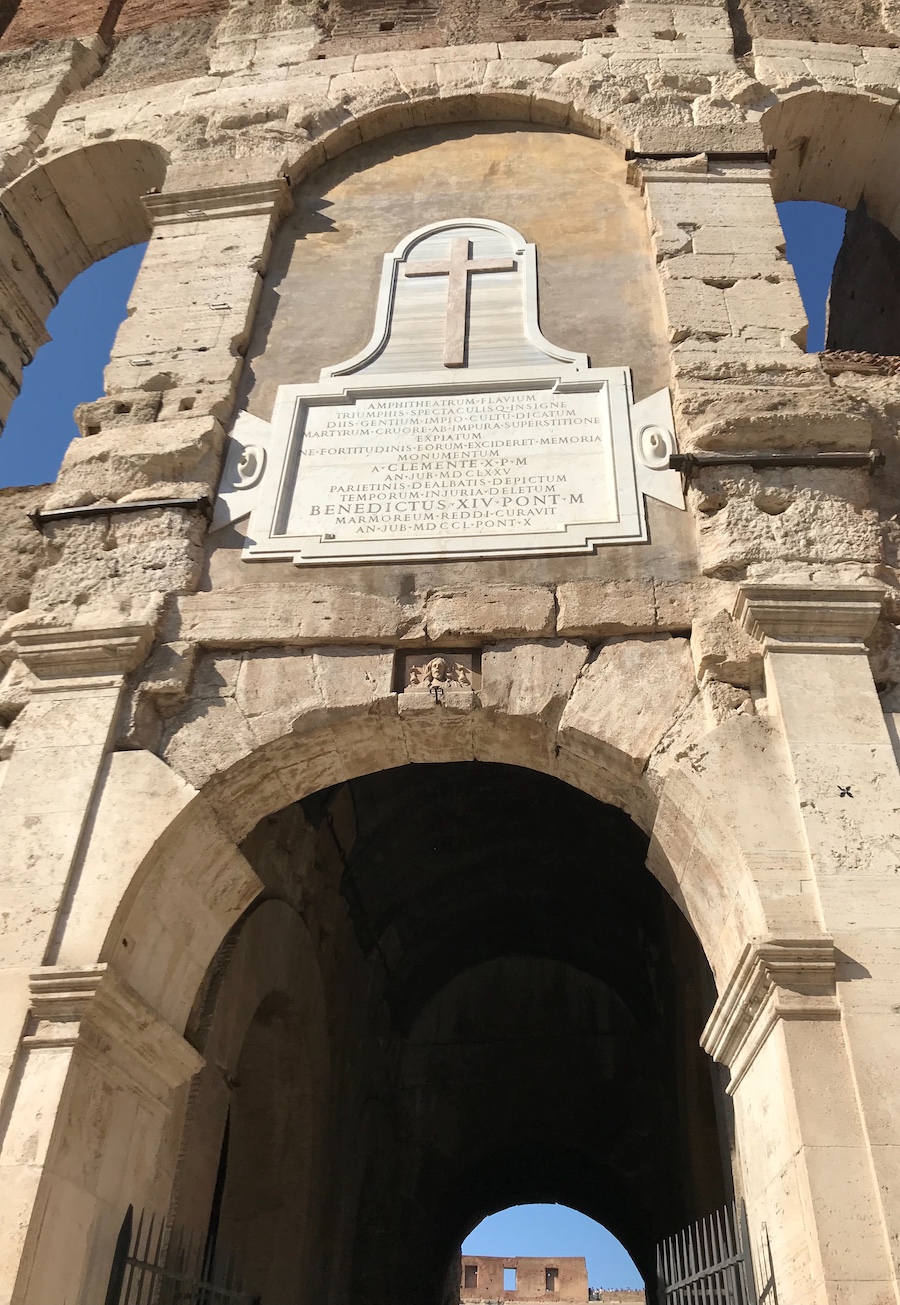
Entrance gate to the Colosseum. Photo: Marina Valcárcel
(Translated from the Spanish by Shauna Devlin)
- The Colosseum, the engine of Roman power - - Alejandra de Argos -
- Details
- Written by Marta S. Galindez
Life is art and art is life ..... or are they just two sides of the same coin? It is figures such as Salvador Dali who bring much-needed light to this shady, eternal question. The Catalonian artist from Cadaqués, one of the most globally important in art history, made himself and his life a joint work of art that has endured over time, complementing his magnificent visual oeuvre and revealing one of the most fascinating personalities of the 20th century. “The uniform is essential in order to conquer. In my entire life, rare have been the occasions when I've demeaned myself by wearing civilian clothing. I'm always dressed in my Dali uniform”. The artist reflected on these comments in his book Diary of a Genius, where his patent self-love jumps out from the page ~ an egocentric attraction that made him many enemies.
Dali: art, egocentricity and provocation
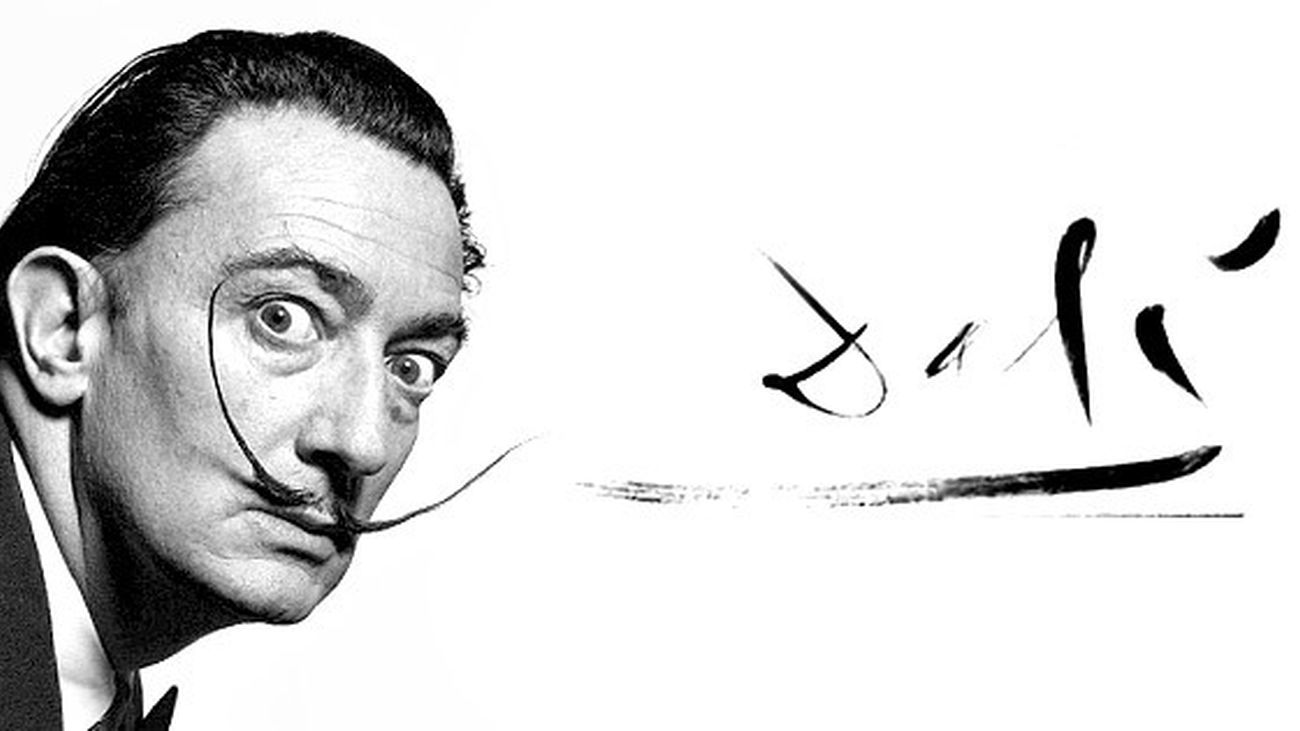
Portrait of Dali with signature. Poster for the exhibition "Dali" organised by the Reina Sofia Museum, Madrid in 2013 c/o Telemadrid.es
Life is art and art is life ..... or are they just two sides of the same coin? It is figures such as Salvador Dali who bring much-needed light to this shady, eternal question. The Catalonian artist from Cadaqués, one of the most globally important in art history, made himself and his life a joint work of art that has endured over time, complementing his magnificent visual oeuvre and revealing one of the most fascinating personalities of the 20th century. “The uniform is essential in order to conquer. In my entire life, rare have been the occasions when I've demeaned myself by wearing civilian clothing. I'm always dressed in my Dali uniform”. The artist reflected on these comments in his book Diary of a Genius, where his patent self-love jumps out from the page ~ an egocentric attraction that made him many enemies.
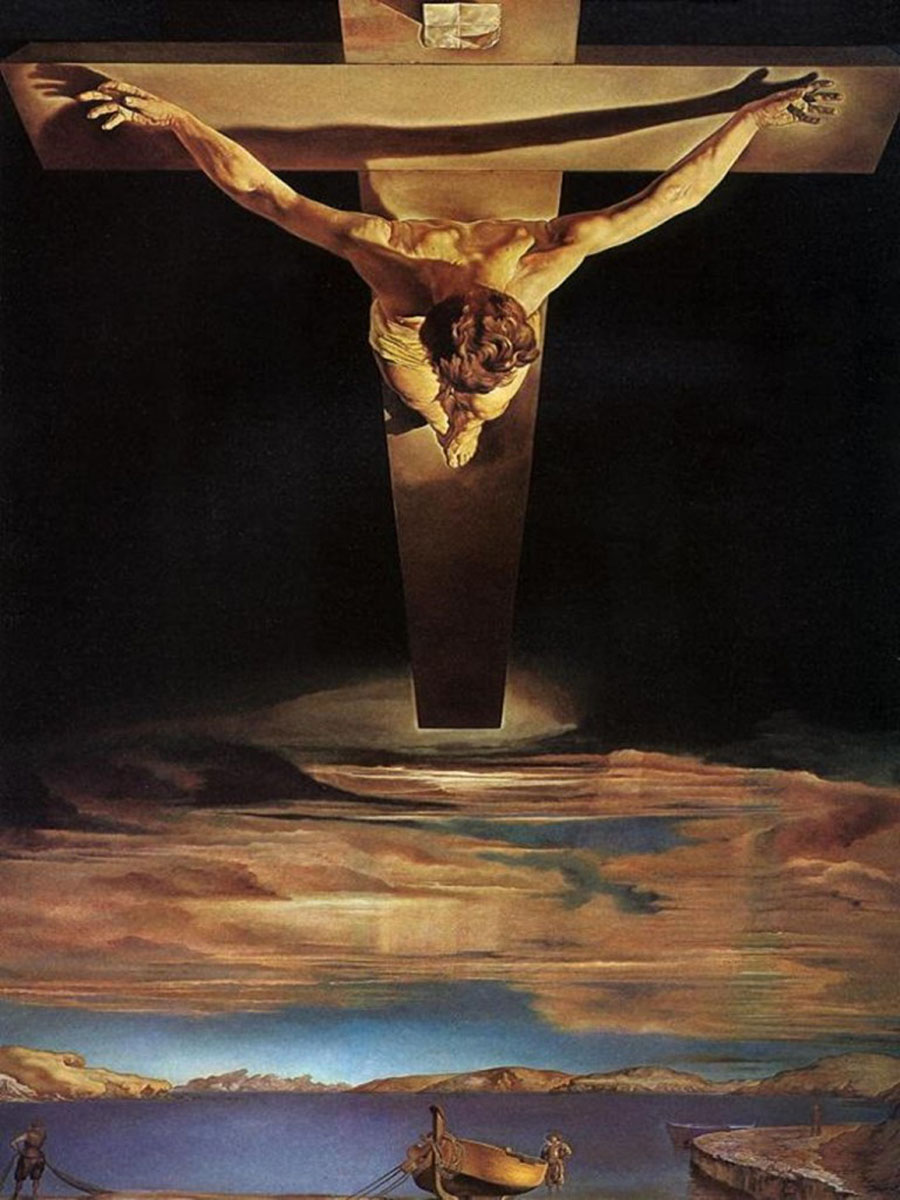
Christ of St John of the Cross (1951). Kelvingrove Art Gallery and Museum, Glasgow c/o Totenart.com
Controversy, mystery and genius were Dali's constant companions. As an artist, he left an immortal legacy; as a person, he gifted society his unforgettable persona; and as a writer, he produced an extraordinary, intimate and recently-revindicated body of work. Today, people queue around the block at exhibitions all over the world and any news concerning his life provokes huge interest. Dali collaborated with and/or had links with greats such as Garcia Lorca, Picasso, Buñuel and Hitchock, creating images and works that remain in our collective subconscious to this day. Accompanied and awed by the powerful character of Gala, his muse and wife til the day of her death, Dali forged his own particular, spectacular imagery that has passed the test of time and become an integral part of contemporary culture, generation after generation.
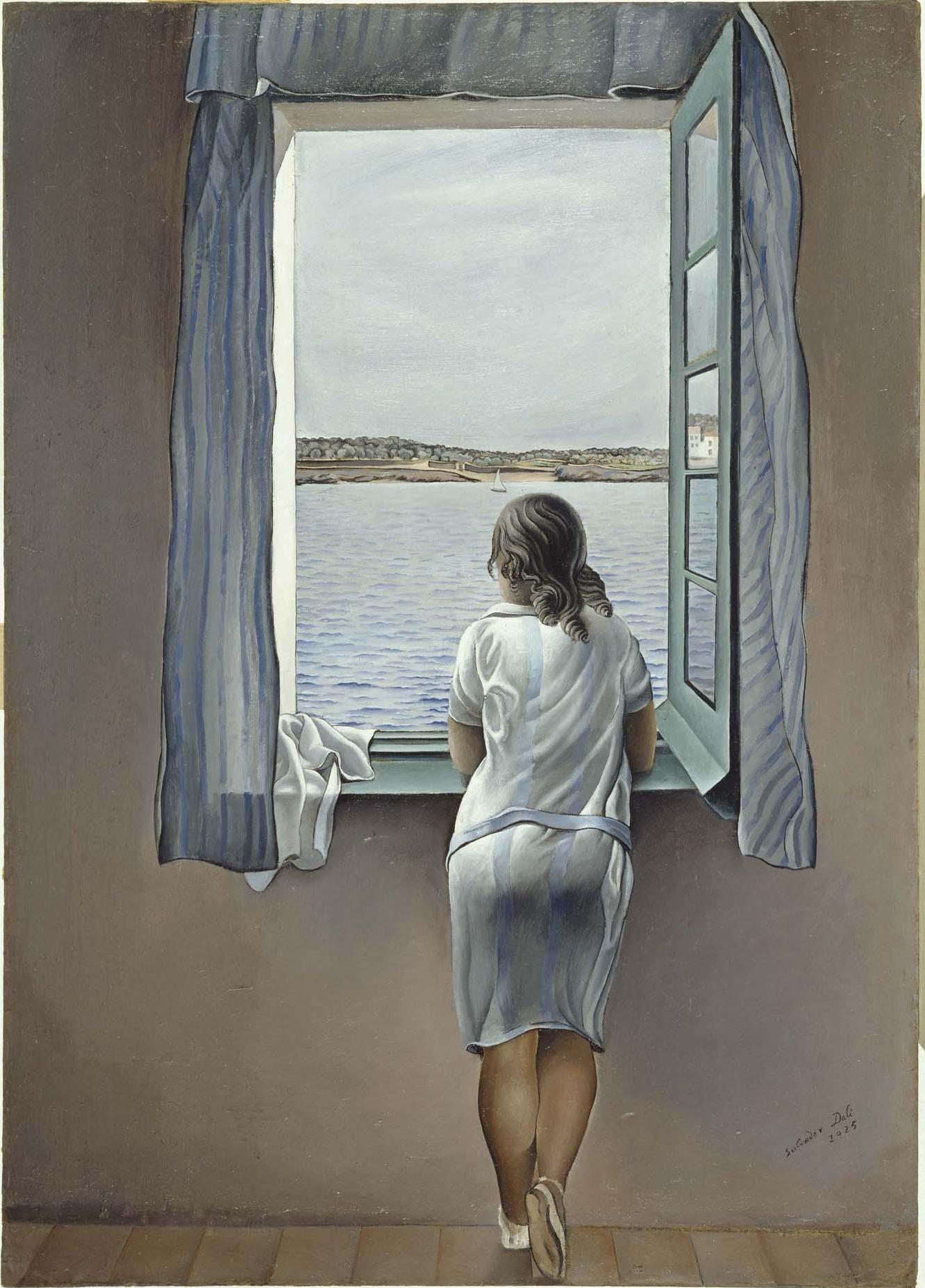
“Figure at a Window” (1925). Reina Sofia Museum, Madrid c/o Museoreinasofia.es
Early years: mediocre student and budding artist
Salvador Dali was born at the turn of the century in Figueres (Girona) on 11 May 1904 to parents Salvador Dalí Cusí and Felipa Domenech. His education began in 1908 in the local state school but his father enrolled him at the Hispanic-French Immaculate Conception College four years later. Dali turned out to be a mediocre student but, after coming into contact with Impressionism through the works of Ramon Pichot, his life takes a different turn. In conjunction with attending school, in 1916 he also begins drawing classes with the painter Juan Núñez.
In 1919 and at the remarkably young age of fifteen, Dali takes part in his first exhibition at Figueres Town Theatre. Unbeknownst to him, this was a moment that would eventually come full circle and culminate in the transformation of the building into the Dali Theatre-Museum, inaugurated in 1974. He also takes his first steps as a writer, something he was absolutely passionate about and that he often gave more relevance to than his plastic art.
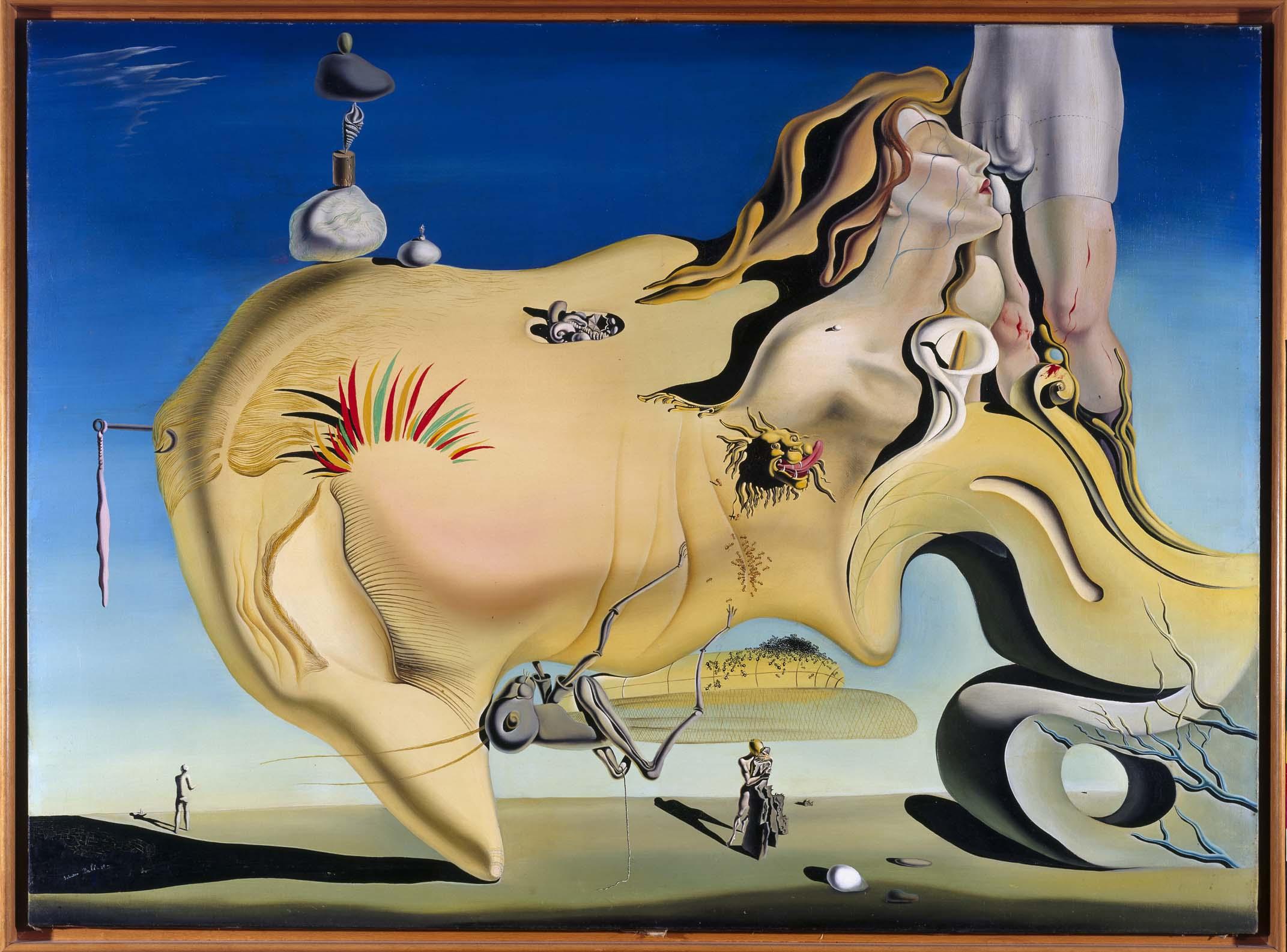
“The Great Masturbator” (1929). Reina Sofia Museum, Madrid c/o Museoreinasofia.es
From Figueres to Madrid: the Academy years
The father figure remained omnipresent in Dali's work throughout his whole life and it was his father who allowed him to train as an artist, on condition he studied at the School of Painting, Sculpture and Engraving at Madrid's Royal Academy of Fine Art. Dali willingly accepted. His mother's early death in 1921 saw her presence relegated to the background as his father remained the most important influence on his life. Their relationship was always plagued with confrontations, disagreements and subjugation but was also marked by Dali's profound admiration for his father.
During his training in the Spanish capital, Dali moved in the same circles as intellectuals, filmmakers and writers of the standing of Buñuel and Garcia Lorca, among others. In 1923, he was expelled form the Academy and returned to his birthplace, where he studied engraving techniques. In under a year, the budding artist had returned to Madrid and participated in his first exhibitions there. During this time, he renounced the avant-garde and pursued traditional Spanish and Italian painting. In 1926, he was expelled definitively from the Academy, returned to Figueres and devoted himself entirely to painting.
Film ~ “Un chien andalou” (1929)
Lorca and Gala: two people, two influences
The relationship between Dali and Federico Garcia Lorca has generated countless articles, speculation and controversy in equal measures. After the first few years of friendship, Dali begins to distance himself from Lorca for fear of being associated with the poet's political stance and his widely-known homosexuality. In 1929, Dali travels to Paris and comes into contact with Surrealist artists, which was to be a pivotal moment in his career. He immerses himself completely in a movement that alligns perfectly with his runaway imagination, his egocentricity and his impeccable pictorial technique. A year earlier, his film collaboration with Luis Buñuel, "Un chien andalou" was released in Paris, cinema being one of his passions and an art form to which he would return repeatedly in subsequent years, collaborating with revered names such as Alfred Hitchcock.
The summer that same year saw a decisive incident in the artist's life. He meets Gala, married at the time to Paul Eluard, when they stayed with him in Cadaqués. Gala leaves Eluard for Dali who would continue to show his deep devotion towards her for the rest of his life.
“I am surrealism”: the embodiment of a movement
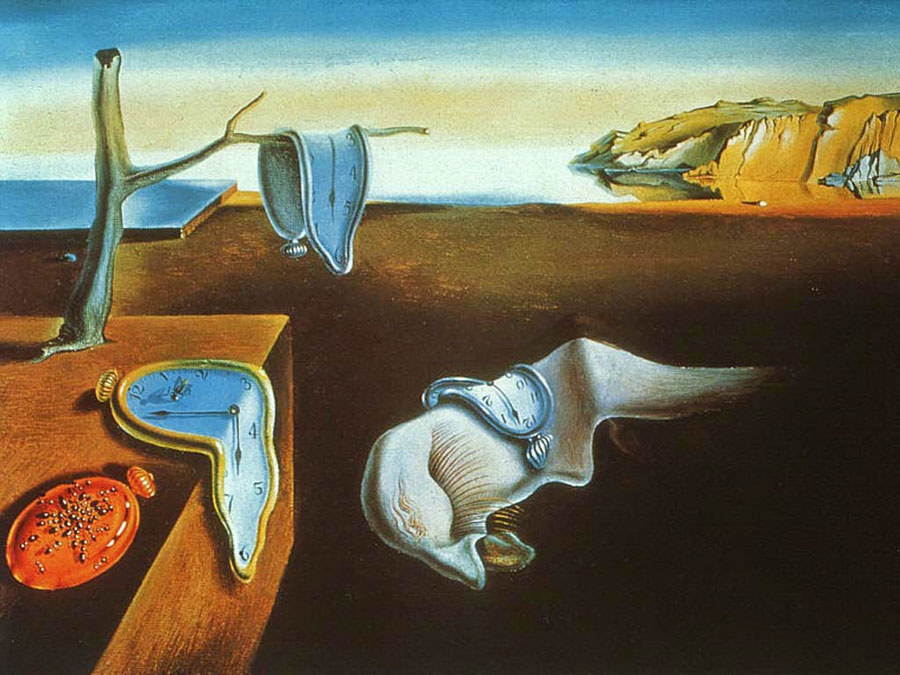
The Persistence of Memory (1931). Museum of Modern Art, New York c/o Artesubastas.es
Dali's commitment to surrealist philosophies and manifestations brought him success from the outset and he quickly became one of the leading exponents of the movement on the world stage, going so far as to proclaim that "I am surrealism". This was not, however, that far removed from reality: Dali had begun to transform his character, his surroundings and his physical presentation into a multi-layered, ever-changing work of art that would continue right up until his death. He even came up with his very own surrealist technique that he dubbed "the Paranoiac-Critical Method" and defined as "a spontaneous method of irrational knowledge based on the critical and systematic objectivity of associations and interpretations of delirious phenomena."
Over the following years, both Dali's personality and his art would become influenced by two great figures: Pablo Picasso, who he met around 1935, and Sigmund Freud, who he interviewed in 1938 thanks to writer Stephan Zweig's intervention.
Boom and bust: the years of decline

“The Temptation of St Anthony” (1946). Royal Museums of Fine Arts of Belgium, Brussels c/o Arteac.es
In the 1940's, Dali's work was beginning to enjoy worldwide recognition. This success distanced him from his old, compromised friendships but won him the favour of General Franco's dictatorship which welcomed him with open arms. His paintings and sculptures then began to show signs of repetition, as Dali renounced innovation in favour of what he knew full well worked for him and the public. His cult-of-self became another of his obsessions and, during the Swinging Sixties, he concentrated on creating his own museum in Figueres, convinced of its historical relevance. Also, from 1965 onwards, Dali began compulsively signing sheets of blank paper for future lithographs and his work became more confusing and disjointed. It was in 1975 that the artist's decline, in health and old age as well as his art, left no room for doubt, a fall culminating in Gala's 1982 death and Dali's seclusion first in Pubol Castle and later in the Galatea Tower.
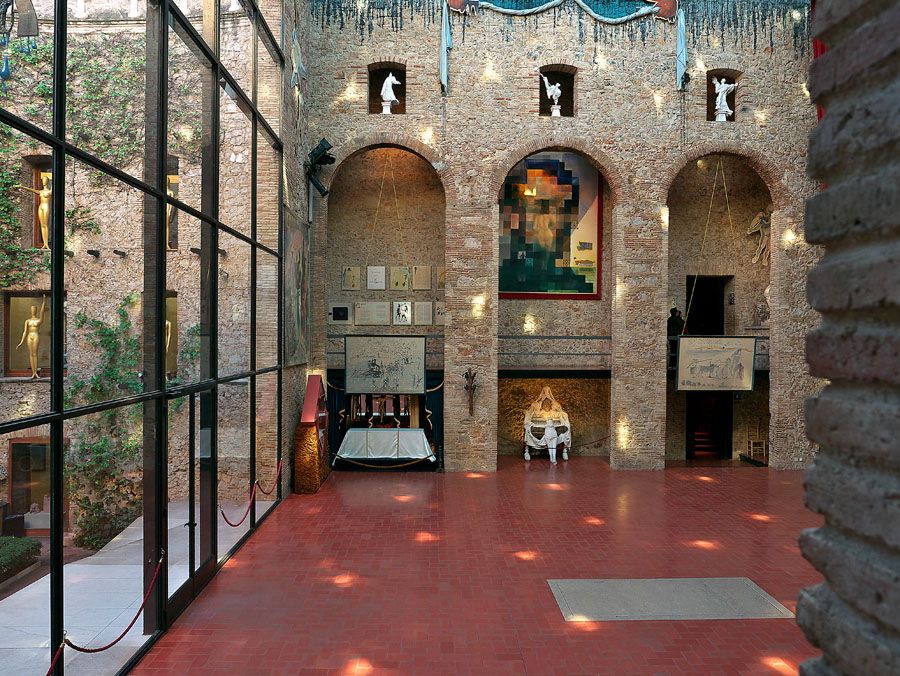
Interior of the Dali Theatre-Museum (Figueras), with the painting "Abraham Lincoln" c/o Wikipedia
Since the 1980's, any Dali exhibition, anywhere in the world, in the greatest contemporary art museums and galleries (such as the Pompidou Centre, Paris or the Tate Britain, London) have attracted huge crowds of visitors. The artist himself, however, was no longer interested in art and, ultimately, succumbed to the worst of his fears, death, and passed away in 1989.
Exhibitions
Exhibitions of Salvador Dali's work are events that spark international interest and attract hundreds of thousands of visitors. Since his first solo exhibition in 1929 until the present, the world's most important museums continue organising retrospectives showcasing the most intriguing facets of his life and work.
Salvador Dali (2012-13)
November 21st 2012 saw the inauguration of a Dali anthology exhibition at the Pompidou Centre in Paris which sold over 760,000 tickets, making it the second most successful ever recorded in the museum's history, after the previous Dali retrospective of 1979 which had attracted 850,000 visitors.
Dali (All of the poetic suggestions and all of the plastic possibilities) (2013)
In 2013, Madrid's Reina Sofia Museum opened what was considered one of the Spanish capital's most important exhibitions of the year: Dali (All of the poetic suggestions and all of the plastic possibilities). The retrospective comprised over 200 works and was one of the most extensive ever dedicated to the artist. In the words of Manuel Borja-Villel: “as opposed to the anecdotal character, we wanted to return to the essential Dali, the artist who is a fundamental figure in 20th century art."
Media: Dali (2015-16)
In 2015, the Gala-Salvador Dali Foundation managed to bring the Catalan artist's work to China in the form of a grand retrospective comprising over 200 multi-media pieces relating to Dali's life and work and including twelve paintings. It was to be the most important Spanish cultural event of the year in a country where surrealism was still largely unfamiliar to its curious audience.
Dali (2016-17)
China was not alone in the sights of the Gala-Salvador Dali Foundation. The 2016 Tokyo exhibition "Dali" gathered together pieces, many of them rarely seen before, from the world's three most important collections (The Dali Foundation in Figueras, the Reina Sofia Museum in Madrid and the Salvador Dali Museum in St Petersburg, Florida) along with other works lent by Japanese institutions.
Books
“The secret life of Salvador Dali”. Salvador Dali, 1942
Dali combined two of his passions in several of his books: writing and the cult of his own personality. This "false" autobiography centres on certain moments in his childhood and adolescence with much irony but not much respect for the truth. Dali recounts the journey from his early years as a student and teenager up to his fame as a world-renowned artist, imbibing each and every page with his inimitable personality.
“Les diners de Gala”. Salvador Dali, 1973
First published in the 1970's, “Les diners de Gala” is an absolute gem that Taschen Books decided to re-edit in 2016. Its pages contain a total of 136 surrealist recipes illustrated with photographs, drawings and collages by Dali. The recipes reflect the artist's powerfully vivid imagination, peppered with erotic references and with excess as their main ingredient. Dali's passion for food is evident here, reflected in the paraphernalia of the exotic dinner-performances organised by Salvador and by Gala.
“The Shameful Life of Salvador Dali”. Ian Gibson, 1998
Without a shadow of a doubt, Ian Gibson's biography of the persona and life of Dali is the most in-depth and exhaustive of those published to date. The Irish author's research brings to light a huge amount of hitherto undiscovered details as he constructs a complex narrative fabric that reveals vast areas of the complicated personality of the Catalan genius. Featured in its pages are the likes of Garcia Lorca, Freud, Picasso, his wife Gala and many other characters close to Dali, thus creating a fascinating, once in a lifetime mise-en-scène.
(Translated from the Spanish by Shauna Devlin)
- Salvador Dali: Biography, Works and Exhibitions - - Alejandra de Argos -
- Details
- Written by Marina Valcárcel
This could be the beginning of a novel: Poseidonia, 5th century BC, and tragedy befalls a family from the local aristocracy. The lifeless body of their only child, a son initiated into Orphic rites, is returned to them from the Wars of Sybaris. The mother covers her son's eyes with Poseidonia's first roses in flower, their praises sung by Virgil for their perfume and twice-yearly blooms. The mother then lays her musician son's lyre, its soundbox a turtle shell, on his breast. As dawn breaks, the father leaves the city walls to commission the most opulent of burials for his son. He seeks out the most gifted painters, those able to create the most moving scenes ..... This article pertains to the story of a burial: an element as intrinsic to the human condition as our own mortality.
|
Author: Marina Valcárcel
Art Historian
|
 |
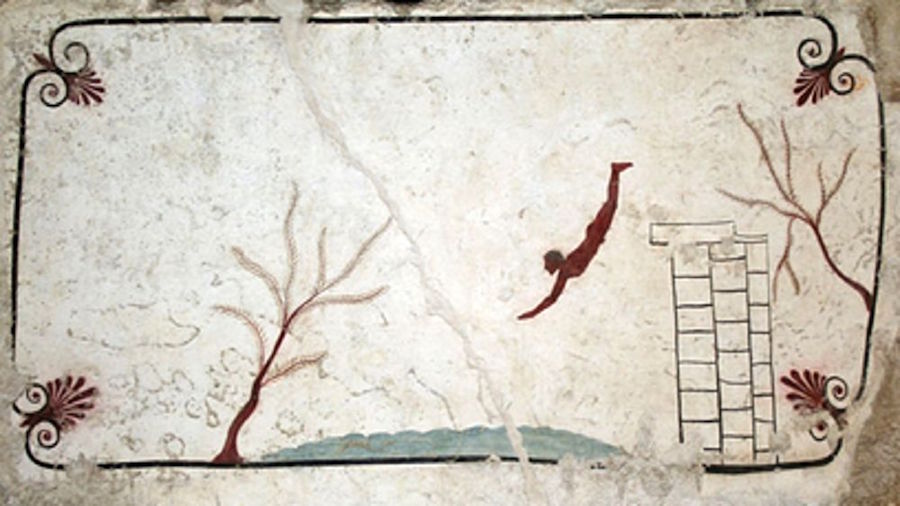
2018 marked the fiftieth anniversary since the discovery of the enigmatic Tomb of the Diver. Now on display at the Museum of Paestum in Campania, its 37-year-old archaeologist director Gabriel Zuchtriegel - yet another German director of an Italian museum - curates the Autumn exhibitions celebrating this ephemeris.
*******
This could be the beginning of a novel: Poseidonia, 5th century BC, and tragedy befalls a family from the local aristocracy. The lifeless body of their only child, a son initiated into Orphic rites, is returned to them from the Wars of Sybaris. The mother covers her son's eyes with Poseidonia's first roses in flower, their praises sung by Virgil for their perfume and twice-yearly blooms. The mother then lays her musician son's lyre, its soundbox a turtle shell, on his breast. As dawn breaks, the father leaves the city walls to commission the most opulent of burials for his son. He seeks out the most gifted painters, those able to create the most moving scenes ..... This article pertains to the story of a burial: an element as intrinsic to the human condition as our own mortality.
A tomb was - then and possibly still now - a sacred place where, as believed among initiates in the Orphic mysteries, the transmutation of death into resurrection, the moment when the soul was liberated from the body, took place. And for that to occur, a perfect setting was required. This is why Egyptian tombs concentrated all their magnificence and all their condensed artistry on the inside. This is why perfection was sealed up and hidden away. And this was because there was a mystery contained within them.
In Ancient Greece, as a partaker in the mystery religions rather than in terms of its Olympian beliefs, the tomb also became a sacred place. They were a kind of magnificent time capsule, decorated almost to perfection, a little chamber that led to another state of being.
On 13th June 1968, the Italian archaeologist Mario Napoli is carrying out excavations at a small necropolis about a mile south of the city of Paestum - the Ancient Greek city of Poseidonia - on the Gulf of Salerno in Southern Italy. As evening falls, he starts work on a fourth tomb that, when finally dug free from the earth, looks surprisingly intact. With the sun setting, the box is opened and, after 2,500 years of darkness, light floods the interior of the tomb once more, bringing some astounding paintings back to life.
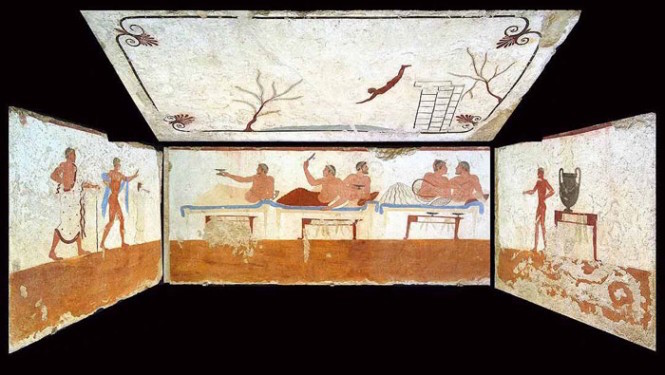
Slabs from The Tomb of the Diver, in their original positions
The four sides and cover of the sepulchre consist of five slabs of local limestone, while the base is dug into the ground. The slabs are neatly bonded together and form a chamber about the size of an adult male. All of the slabs are painted using the 'true fresco' technique but the fact that the one forming the ceiling is also painted is somewhat unusual. Mario Napoli sees for the first time the scene that will ultimately give the tomb its name: a young man diving towards the curling waves in the waters below. The Tomb of the Diver has just been discovered, the only extant example of Greek painting with figurative scenes from the Orientalizing, Archaic or Classical periods to survive wholly intact. Among the thousands of Greek tombs known of at this time (700 - 400 BC), this is the only one decorated with frescoes depicting humans. It is, in this sense, a revolutionary one. The great paintings of Zeuxis, Apelles and Parrhasius have only come to us through narrative tradition and historians but we have never seen them. They exist only in fragmentary form and, of course, in the richness of the amphorae.
Inside the grave and near the body - probably that of a young man - are two objects: the shell of a turtle, once the soundboard of a lyre whose wooden casing had long since rotted away and an Attic lekythos vase in black-figure technique, as used around 480 BC, which helped to date the year of the tomb to around 470 BC. The lateral frescos surrounding the body depict symposium scenes of a traditional Ancient Greek banquet: bare-chested young men wearing laurel garlands reclining on sofas, partying, dancing, drinking wine, playing lyres and games and being in love.
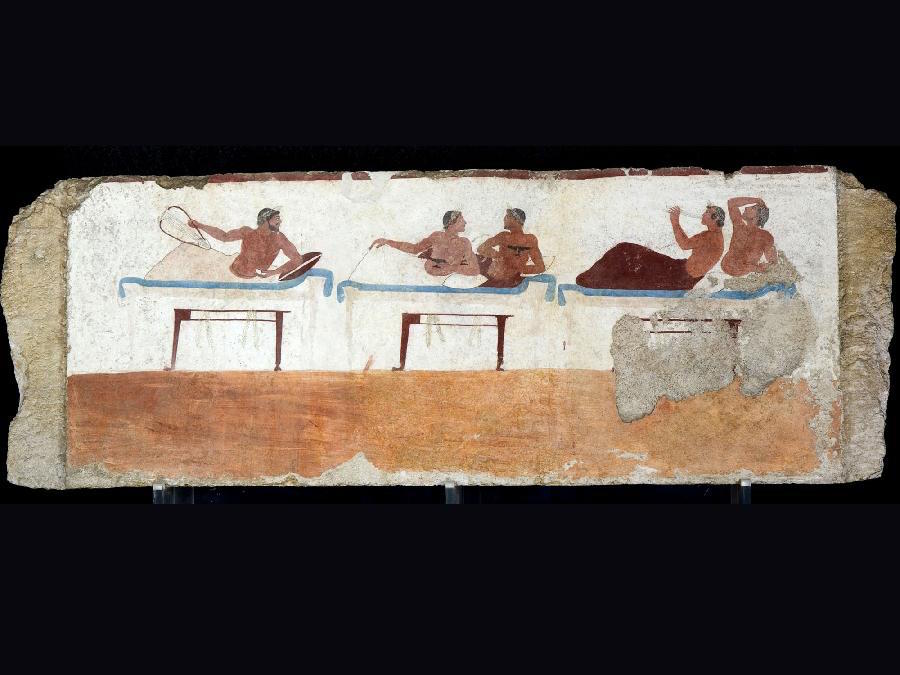
The Tomb of the Diver. North Wall (banquet scene detail)
However, it is the ceiling slab, the one facing the gaze of the dead man, that has been the still-unresolved focus of much contentious interpretation. It is this segment that encapsulates the mystery and the rivers of ink written in archaeological research: a scene bordered by a black ribbon with palmettes in each of its four corners. In the centre, a naked man suspended in the air, diving into the river below. On the right are three stone pillars, presumably his diving board, and on either side are the bare outlines of two trees. And then, nothing. Just the white background, nothing else.

The Tomb of the Diver. Ceiling slab.
In Ancient Greece, neither swimming nor diving were activities the elite indulged in. The swimmer depicted in this tomb, isolated against the sky, symbolizes - the jury is still out on all the hypotheses - the intensity of the moment of death. This man and his leap are the visual metaphor for the transition to eternity from earthly life.
At that time, Greece was living the tradition of its Olympian beliefs, with its bored, mountain-dwelling gods, impervious to earthly needs toying with, for pure entertainment, and torturing mere mortals. For them, the vision of life after death was extremely pessimistic. Without exception, without differentiation, without judgement on the righteousness of their previous life, the souls of all mortals were condemned to Hades, a dismal place where they eked out a miserable existence envying the living.
However, around the time The Tomb of the Diver was constructed, for those living in Magna Graecian cities, new ideas from other Eastern belief systems would come and go in their everyday lives as if by capillary action: the mystic or Orphic cults, for instance, whose occult rites were based on the hope for some kind of life after death. As Pythagoreanism and Orphism spread, only those who had been initiated through a series of secret rituals could aspire to these other-worldly hopes.
And it is precisely this aspect that makes our tomb so special: the metaphysical message it communicates through visual language. Because it is the case of The Tomb of the Diver that the paintings seem to be portraying the central ritual of initiatic, religious practices entailing a banquet in which, through orgiastic stimuli, a state of exaltation and mystical fervour is invoked in the participants. This state recalls the passion of the God Dionysus and his presence inside an animal that was ripped to shreds, its flesh and blood consumed by Titans in a ceremonial banquet. The intense fervency attained enabled participants to feel the force of the soul within the body and this anticipated the experiencing of its liberation from the body which could only happen after death, once the soul had finally departed the body.
Incidentally, this idea of life after death was being propagated in Greece a full five centuries before the birth of Jesus Christ in Bethlehem, Judea. We have here an early precedent for Christianity that would seem to be its replica projected backwards.
It is believed that our young man, who died long before his time, would have been an initiate of these rites. In his tomb, the image of death as a rapid passage through water would remain forever above him. And his body would be surrounded by scenes from a banquet that would never end and in which he would participate for all eternity, playing his lyre with his musician friends.
But who was the young man buried there? What kind of life had he led? How did his parents commission his tomb? What of the two artists who painted it? What did they do with their son's body on the days when the tomb's walls were being cut out of rock, plastered, dried out, chiselled to outline the drawings and then filled in with vivid colours? And again, why paint a magnificent tomb to be seen at the precise moment of burial only to seal it up immediately, never to be seen again?
An invisible image
An invisible image is a challenge. What happens when an image, painted 2,500 years ago never to be seen again, bursts onto our contemporary, traditional, cultural landscape where being comprehensible is the equivalent of being visible?
One thinks of other images in art history with encrypted messages, from Malevich's Black Square or the mysterious Romanesque frescos of San Baudelio de Berlanga to the prehistoric Altamira Cave bison and the inscriptions on the earliest Christian catacombs and Banksy.
Perhaps what's puzzling about The Tomb of the Diver is not so much the impossibility of deciphering its meaning but rather our attempts at coming to terms with the powerfulness of an image's intrinsic ambiguity.
The temples of Paestum and The Tomb of the Diver
On this October day, the grassy area surrounding the temples of Paestum is empty of visitors and full of autumn roses. The three Doric temples appear erect and severe in their golden Campania stone, about 90 kms from Naples and the shade of Vesuvius. The Temple of Neptune (460 BC), thus called but wrongly attributed to Poseidonia's protective divinity, is, for many scholars, the best preserved temple in Greek civilization. It is not easy to describe the powerful impact of seeing its facade, devoid of any decoration whatsoever, not even holes in the stone that might have allowed us to imagine there once being a statue clamped into its tympanum, nothing resembling the Pantheon or Phidias's statues of gods, horses, warriors, ..... This temple was conceived of to be bare and stern, even in its triglyphs and the metopes between. No goddesses on horseback. The tension is achieved solely by its monumentality, by the magic of its proportions, by its second row of intact columns, with its fluted pillars high as a forest and its orientation towards the East.
The Temple of Neptune. Paestum
In the 8th century BC, the Greeks were sailing the Tyrrhenean Sea around the mining regions of the Etrurian coast to buy metal. They settled near Ischia and so began their campaign of colonisation. Around 600 BC, sailors from the city of Sibaris founded the colony of Poseidonia, making it one of the northernmost extremes of Magna Graecia. It was then conquered by the Lucanians and finally, in 273 BC, fell under Roman rule and was renamed Paestum. The discovery of Paestum came in 1752 when King Charles VII (the future Charles III of Spain) ordered the construction of a road which would cut across the city. From then on, European intellectuals doing the Grand Tour, amazed by how well-preserved the temples were, made it their reference point for classical architecture until Athens was added to the European cultural itinerary. It was specifically in Paestum that Greek architecture achieved supremacy over the Roman and where the Greeks regained their "tyranny" over Europeans enamoured with their monuments. Winckelmann (1758), Piranesi (1777), Goethe (1787), John Soane (1779) and almost all the great architects of the time came here to see, study and measure the purest of all Doric temples. In 1758, the architect commissioned to build the Pantheon in Paris, Jacques-Germain Soufflot, found inspiration in the temples of Paestum, making the Neoclassical style so popular in France it would end up replacing the Barroque.
National Archeological Museum of Paestum
Vía Magna Graecia, 918
Paestum
Italy
(Translated from the Spanish by Shauna Devlin)
- Una imagen invisible: la tumba del nadador - - Alejandra de Argos -
- Details
- Written by Elena Cué
Jack Ma ( China, 1964), founder and chairman of Alibaba Group, one of the leading tech companies in the world with Google, Facebook, Amazon and Microsoft. He is in the process of implementing five new strategies that will drastically disrupt the ecommerce market today. His goal is to start a transition and start delegating the steering wheel of his company to focus on what is truly important to him: philanthropy. Through his Foundation, Jack has one great plan: to rethink and disrupt the current global education system so that it can face the challenges of the digital era.
Author: Elena Cué
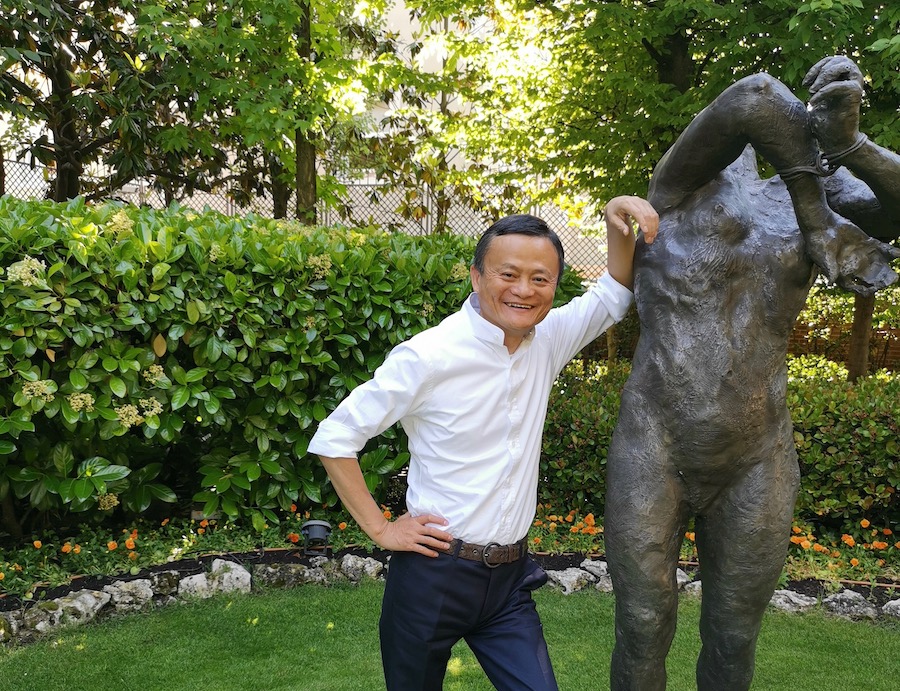
Jack Ma. Photo: Elena Cué
Jack Ma ( China, 1964), founder and chairman of Alibaba Group, one of the leading tech companies in the world with Google, Facebook, Amazon and Microsoft. He is in the process of implementing five new strategies that will drastically disrupt the ecommerce market today. His goal is to start a transition and start delegating the steering wheel of his company to focus on what is truly important to him: philanthropy. Through his Foundation, Jack has one great plan: to rethink and disrupt the current global education system so that it can face the challenges of the digital era.
The Jack Ma foundation you started in 2014 gives support to schools in rural areas in China. What are your future plans in that area?
There are close to 40 million students and young people living in poor rural areas in China. I think the best way to help kids is to help their teachers. Teachers in rural areas have very poor conditions. They are not respected and no one cares about them. We are trying to build a system to encourage, inspire and support them. Another way to help teachers is to train their headmasters. Most teachers give up on teaching because they do not like their headmasters. Headmasters in rural areas have never received even an hour of training, so how could they inspire teachers? That prompted us to start this program.
Unfortunately, a lot of schools in poor areas do not have enough kids. Each school has about 15 students in each grade. We try to combine them and create boarding schools with over 100 students. Teachers love to go and teach there. China, Africa and a lot of developing countries are experiencing the same problem. We are developing a huge plan. We want to improve the model we have in China and then use it in other countries. The other thing is how we can use internet and technology to train students, teachers and headmasters. I am really interested in this type of education.
Another remarcable program of your foundation is the African Netpreneur Prize that awards one million dollars and is currently open to all African technological entrepeneurs. What are your goals with that initiative?
Africa needs three e’s: eGovernment, eEducation and eEntrepreneurs. An eGovernment will be efficient and transparent. eEducation would be the foundation. Then, If they have great entrepreneurs, they will improve Africa’s economy significantly. What we do is encourage entrepreneurs and turn them into the new heroes of Africa. We inspire them to hire more people, to be more creative, to improve the economy. Just like what China has done for the past 20-30 years. I have been working on entrepreneurships in China for more than 20 years. I have personally built six companies that are all very successful today. I figured out ways to train and develop people to be entrepreneurs. I want to encourage that in Africa. My foundation gives one million dollars to ten African entrepreneurs every year. The purpose is to create successful case studies for entrepreneurs in Africa. Regardless of the country, area, age and type of business. It is not all about technology. If you run a successful barber shop or a restaurant, you can still receive an award. We want to show Africa that there are a lot of entrepreneurs and there are many ways to upgrade them.
Considering the current exponential development of technology, transhumanism and artificial intelligence, what do you think should education be focused on in this new world that is coming?
My view is that the whole education system needs to be upgraded. Today’s education system was designed several centuries ago during the industrial period. It trains people to remember and calculate things; it makes people smarter and more hardworking. Unfortunately, we are moving from an industrial period to a digital one. Over the past 30 years we have been trying to make people like machines. In the next 30 years we will be making machines like people. The current education system trains people to compete with machines.
Is not that an impossible battle?
Yes, there is no doubt in the digital age in which we live. The only way to succeed is to start teaching our kids to be more creative, constructive, innovative. This is the way the education system should follow. We have to train our kids not to have to best scores but to be the best version of themselves because no matter how hard you work on remembering and calculating things, a machine will always be able to do it much better than you will. If we do not change the way we teach, our kids will be in big trouble in the future. In the age of information explosion, we should teach our kids to have independent thought.
Now, the human beings worry a lot about artificial intelligence and robots...
But I do not. Robots are machines, they do not have a heart. They only have a chip. A chip can never dream like a heart does. The heart has love, dreams and creativity. If human beings only use their brains, no matter how hard we work, we will not be able to compete against the machines. Heart is about EQ and brain is about IQ. If we only compete with our IQ, we will be gone. We have to compete with our EQ and LQ plus our IQ. That is the educational system that the world needs.
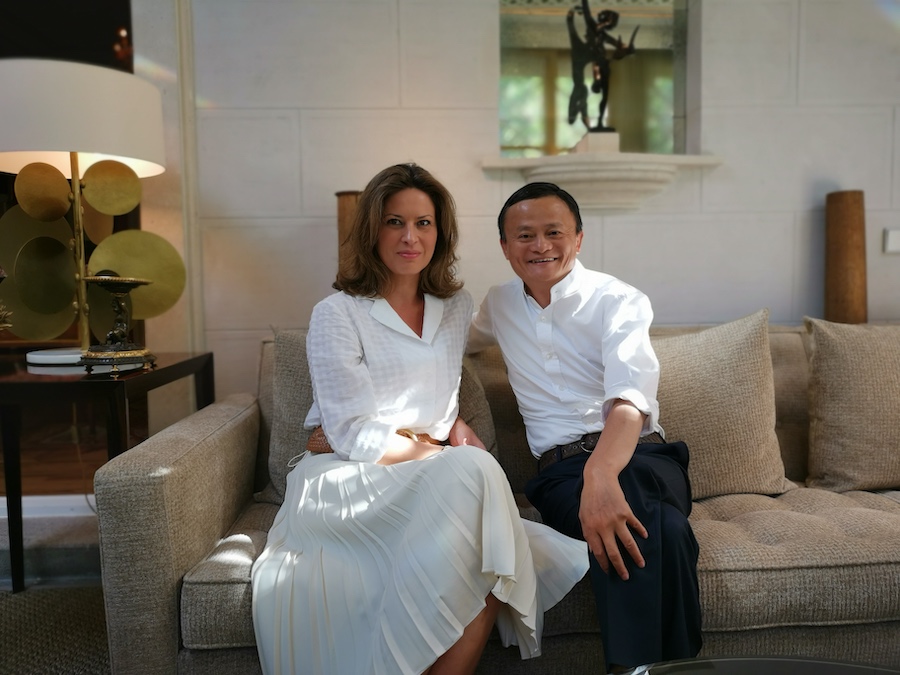
Jack Ma and Elena Cué
What does creating the E-commerce world giant Alibaba Group mean to you?
What we want to do is not to just make E-commerce. Alibaba facilitates all aspects of business. During the industrial era, only big companies were successful. They had the money, resources, network and technology. However, 99% of the businesses worldwide are small businesses. So we want to help small businesses compete and be prosperous. Today, Alibaba does everything to empower small businesses and young people to grow. Our dream is through technology to enable that every small dream comes true. That is why we focus on marketplaces. We build logistics, financial and cloud computing systems. These are the systems that can improve any small business and make it competitive. In the beginning nobody believed my vision but in the past 20 years all companies that have used our marketplace and systems have gone on to be successful.
How are Alibaba and Aliexpress different from Amazon?
We are not an E-commerce company. Amazon is an E-commerce company. We are helping companies become E-commerce companies, to become Amazon. People think we are the Amazon of China but it is not the case. We believe that any company can follow the Amazon model. We help them deliver, pay and receive money, reach the market and have the same technology capabilities as Amazon. That is our vision and what we think the world will look like in the next 10 to 20 years. And for that reason we have been able to create companies like Ali Cloud, one of the leading cloud companies in the world, Ant Financial, one of the world's main financial companies or Alibaba City Brain, a mayor global solution for control and monitoring of all the systems of large cities through an Artificial Intelligence brain.
Amazon buys and sells...
We do not, we provide solutions to companies. If you have an IT problem, we offer you cloud computing. If you have a delivery problem, we provide the logistics. If you are having issues reaching the market, you can use our resources.
What changes of your "Five Big New" strategies do you consider will be the most important in the future?
In the next 10 to 20 years we will be moving into the new retail. It is redefining the way retail works. Offline shops are waiting for customers to come. New retail is offline and online combined. It is no longer you going to the shop, now the shop goes to you. New retail has new manufacturing as well. In the old days, manufacturing was about ideas and engineering, making a product and selling it in the market. Because of data, in the future we will know exactly what everybody wants so we will be able to tailor-make it. In the past it was B2C (business to consumer), now it is C2B (consumer to business). The financial system of the past was the big banks looking for a customer who would like to invest. In the future, we will empower every small business that needs money. As long as they have a good credit rating system, they will get finances. We are redefining the financial system.
Cloud computing and internet technology is going to replace traditional technology. In the last century the competitive advantage was oil, this century it is data. Without data, it is difficult to customize and be innovative. Data is very important. These are the five elements that we think are going to change the world significantly. At first, the retail and manufacturing industries will not like it. Successful people love yesterday. But successful people only represent 20% of the population. What we want to do is make 80% of people more successful while making sure everyone is competing for the future, not for yesterday.
How can Artificial Intelligence help humanity?
Every technological revolution brings a disaster. The initial intention is always good but the consequences are not. As I said in Paris and New York, the First Technological Revolution, directly or indirectly, caused World War I. The Second Technological Revolution again, directly or indirectly, caused World War II. Now we are in the Third Technological Revolution. If human beings do not respect it, embrace it and lead it into the right direction, we may have some big problems. If there ever is a World War III, it should be a war against poverty, disease and environmental issues. Humans should use technology to solve their problems instead of using it to become more powerful and compete against each other. That is crazy and stupid.
What is the greatest contribution of the current Technological Revolution?
The first technological revolution relieved human energy. The second relieved distance. The current one relieves the brain. It will bring challenges but it will make human life better. I am 100% sure about that. The only issue is how we are going to train and develop our current and future generations to be ready for it. If you are not ready for that technology, you will be scared. And with fear comes problem. It is not the young people or poor people who are worried about the technological revolution, it is the powerful rich people and developed countries. That is very interesting. Artificial intelligence is coming. You can not stop the new technology but you can change yourself and embrace it. Technology should be used for good deeds. Tech companies have to take responsibility. Especially companies like us, Google and Amazon. We have a big responsibility to care for issues like jobs, privacy, etc. Only then will we grow together.
The Alibaba Group continues to grow dramatically. What do you think has been the key to its success?
First, you have to have a vision. Many companies tend to lose their vision as they grow. They always think about the current or next quarter. When you lose your dreams, you become a machine and human beings are not machines. In order to keep our company growing, we always think about the future. Compared to yesterday, we are big but compared to tomorrow, we are still a baby. The second key is people. You have to find the people that believe in the future. People who are innovative and are willing to work day and night. The third key is to respect your competitors. A competitor is not an enemy. If you think of your competitor as an enemy, it will be terrible for you. You have to learn from your mistakes and change yourself. I think I am lucky because I was trained to be a teacher. As a teacher you look at every student differently. You respect and love them for who they are. I have spent most of the past 20 years training and developing people. I think of them as generals fighting on the battlefield. We must believe in the future. It is important to know how to build a team as well. It is not about hiring the best people, it is about finding the right people who have the same vision and values as you. And then it takes time.
You said that the fact that 47% of your employees are women has contributed to your company’s success. In which ways do you think they did?
We no longer have 47% as we have just acquired two big companies with mostly male employees so that percentage lowered down a bit. I am giving my plea to the team so we can get back to those figures. If we have it below 33%, then we have a problem. I did not know we had so many female colleagues in the company until an American journalist asked me about it. I did not realize it at the time. Then I looked it up and realized it was true. More than 34% of our senior managers are women. That is a lot of women leaders. AliBaba became so popular on the internet. 15 years ago I told the team that the computer is all about code. However, it is not the computer talking to another computer, it is the people behind the computers communicating with each other. The computer is only a tool. We thought about making our services, software and products more human-like, more considerate. We found out that women do a better job on that. Women care about others much more than men. Unfortunately, men care more about themselves. Women care about their husbands, children, parents. They are more considerate. You need more people that care about others in your company. Women are more loyal as well. It is very difficult for other companies to steal them as employees. If you treat them fairly, they will be very loyal. We have so many great women leaders and employees at our company. Men think about what they can get. Women think about what makes them happy. In this century there will surely be more women leaders, not only in business, but in the world itself. The world will be more balanced.
You know women very well.
We have 700 million active buyers on our website every month. More than 70% of them are women. Women not only buy for themselves but for others. They are big shoppers but not necessarily always shopping for themselves. Look at what men are buying; they either buy things for themselves or a gift to impress a woman. That is human nature.
You have included the practice of Tai Chi Chuan, which you consider essential for your life, as part of your employees’ working day. Why is it so important to you?
Tai Chi is a philosophy about balance. It is about hard and soft, fast and slow. This is the philosophy I like. No matter how strong you look, you should be very soft on the inside. If you want to live longer, you should not do much exercise. Turtles do not move but live very long. However, if you want to live a healthier life, you should exercise more. That is how health and longevity compare. Turtles have a lot of diseases but they manage to live longer because they save energy. A lot of animals who run fast, do not live long. That is the balance. When you create products for your customers, you should also have this philosophy in mind. A lot of young people love to move fast. If slow is done properly, it ends up being fast. This is the philosophy I want to bring to the company. In the western society young people like boxing. Boxing is fast but how many years can you do boxing? By 50 you are gone. With Tai Chi, when you are young it does not make any sense. But when you reach 50-60, you get a much more balanced body. I want to make companies live longer with a philosophy behind them. If you only live for the next quarter, forget it. If you want to live 100, 200 years, you need to think about the culture that will make you live longer.
The most important thing about a company are the employees ...
In our company we believe everyone should treat work happily but treat life seriously. I always say “Do not work too hard. Please work happily.” I hate when people work very hard. How can they last? Only when you are happy, you get creative and innovative and you last long. When you find the click of happiness, a fountain of ideas comes out.
You are a board member of The Nature Conservancy and you also built the Paradise Foundation in China. What is your involvement in the preservation of the environment?
I have been heavily involved in environmental issues for the past 10 years. I worry about the air, the water. I spoke a lot on the subject and pushed governments to do something about it. Now, the Chinese government is finally starting to worry about the environment so I’ve started to pay attention to the things that people do not see, i.e. education. When everybody starts to pay attention to the environment, then you should turn your attention to other issues. There are no accidents on a very crowded road as everyone is more careful. It is the street with no traffic where accidents happen. We are learning from the US and Europe and their experience with protecting the environment. What I want to do is wake up the consciousness in society. The protection of the environment is a huge problem. If we do not take measures, there are going to be problems for all of us. It is so contagious and needs to be controlled.
What do you think is the secret to be able to fulfill our wishes?
The secret is your will. You should seriously believe this will and not because other people believe in it or society thinks it is right. You have to believe it with your heart. Then you have to find the people who believe it and you have to take action. And you need time. It is not something that happens overnight. You have a wish you truly believe. You find a group of people that truly believes in your wish. You have to be ready to take action and make mistakes every day. And then time keeps on moving, things will change. It is not a one day change. A lot of smart people with values and vision fail because of the time aspect.
What do you think about our country Spain?
I love it. The first time I was here, it was a cloudy day but the second time and this trip it has been great. The weather, the people, the culture, the food. I think Spanish food is much better than French food. It is more natural and healthier. Your culture has a bit of adventurism, romanticism, dignity. It is amazing. Spain needs to be known by more people around the world. I consider myself lucky to have been here three times. I would love to come here more often. Since my first visit to Spain, I have always tried to come more often. When they ask me which is my favorite country abroad, I always answer Spain.
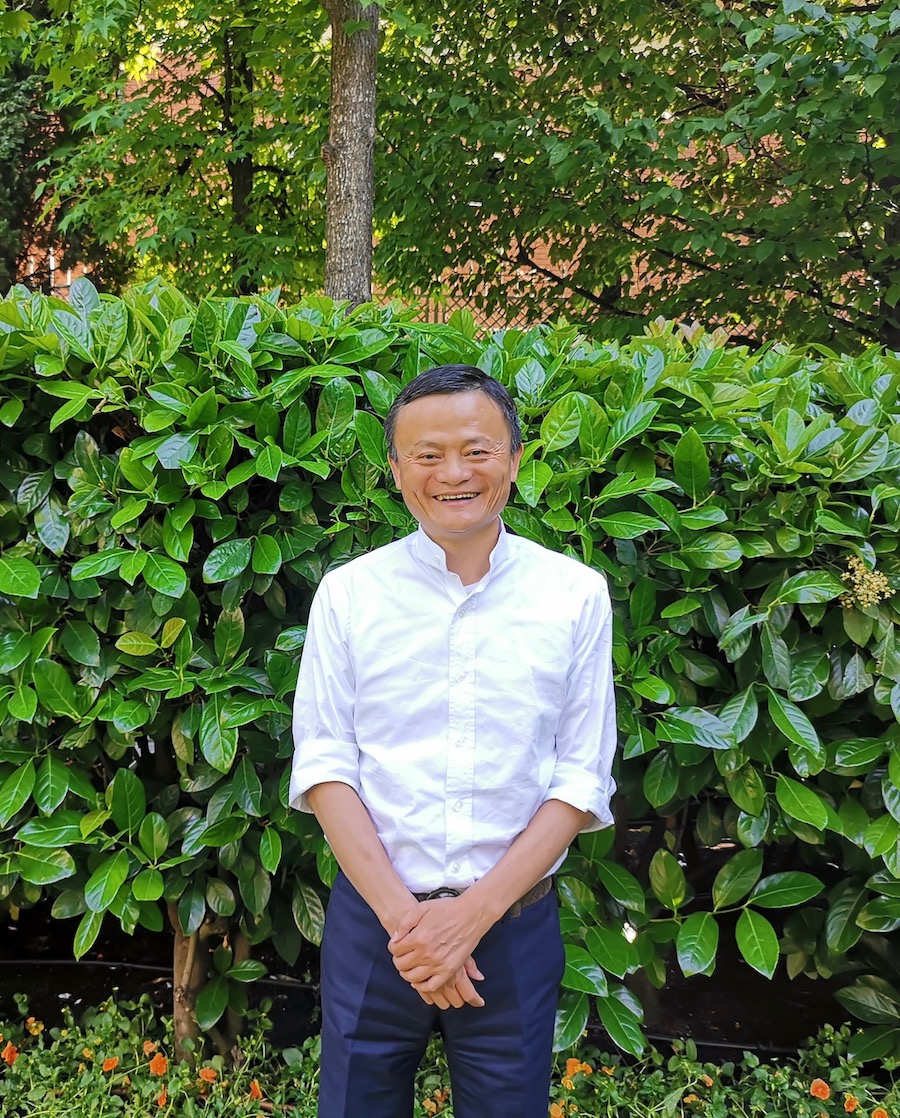
Jack Ma. Photo: Elena Cué
China has become one of the greatest world powers. What factors do you think have been key in the remarkable development of China?
In the past 40 years, what China has done is to start learning. Learning is so important. China used to be so closed. When a country or a person is closed, he/she refuses to learn from the others. What does close-minded mean? It means you refuse to learn new things. China opened its mind. We have learned from the US, Japan, Europe. Our people are so hardworking because we have been poor for so many years. For example, today in China, in a city like Beijing or Shanghai, if you take 100 young people, 90 of them can speak at least 20 English words. But if you go to New York or Washington and take 100 American young people, how many of them can speak a foreign language? Why? Because we have learned. Learning and hard work can change everything. The other factor is that China really respects knowledge. It is improving a lot. In the early days, we took on a lot of the outsourced low-end work from the US related to road work and clothes manufacturing. We did not care, we just wanted to do it. Everyone can be successful if he/she works hard. You do not care if it is big or small, you just do it. There are a lot of reasons behind China becoming the second largest economy. This is something that the world should see and respect. We are hard-working, we learn, we are open-minded. Of course, there are still a lot of things that China needs to improve.
For example?.
China only just connected to the world in the past 40 years. USA, Europe and Japan have been connected for the past 100 years while we have just opened up. We do not have an international language in order to communicate. There are a lot of problems. It is the duty of people like me. I travel around the world in order to learn to communicate. I go back to China and tell people and businesses there. Today a lot of problems arise because a chicken is talking to a duck (Cantonese proverb: miscommunication due to a language barrier) They are very angry so they do not talk. There should be a language that they can use to communicate. People do not respect you because you have money but because you take responsibility. China has been learning to survive, to develop economically and to take responsibility. That is the big lesson that us Chinese are learning.
Thanks to Alibaba's and Ant Financial, China is today the most advanced financial service industry in the world. Among your achievements are having being able to have 100% security on all transactions, both on the front and back end. People do not need a wallet or a credit cards any longer, this has greatly increased the financial inclusion of the population and now you are able to pay using your face thanks to facial recognition. Could you tell me more about the "3-1-0" method of Ant Financial?
This is a very good question. I started studying interfinancial issues 15 years ago. It was very interesting. At that time at Alibaba, I found an interesting opportunity online. A person wants to sell. He finds you but you do not know how you can buy from him. He offers you his product and demands your money. But if you give him the money and do not receive the product, you will be cheated. At the same time the seller is worried about getting the money himself/herself. I found that this kind of issue lasted for long and there was no solution. So I went to the bank and asked for help in order to solve this problem. The bank did not trust this model and thought our business is too small. I was frustrated so I decided to build our own financial system to be the export of service. I act as a middleman between buyer and seller. The buyer deposits his money to me. If he/she likes the product, I release the money. If he/she does not like the product, I give him his/her money back and return the product to the seller. That was a very simple model. Everybody at the time was telling me how stupid it was. I did not care if it was stupid as long as it worked. The government did not give us a license as there was no such model to use as a reference. I went to Davos World Economic Forum and heard Clinton speaking about leadership being about responsibility. It inspired me to take action. As it was such a simple and easy model, it became really popular. Everyone started to use it. There is even a bank that is using it now. The funny thing is that banks hate it. Normal banks need 500 people while we only need 15. Regular banks charge transaction fees of around 50 dollars while we can do that with 3 cents. In order to survive, you have to think about how to be quick, efficient and cost-effective so you can compete with the banks. The ‘310 model’ is open to everyone in China today. If any company wants to borrow money from us, they can apply through a mobile or a PC. Within three minutes of filling the forms our machine tells you if you are approved or not. The money will then be in your account within one second. It is all credit score based. No one actually touches the money. That means that people do not have to drink wine with bankers in order to get a loan. There is no bribery. We do not want our employees to talk to any of our customers because the data will tell us whether they are good or not. The banks were so scared for the past 10 years. You can borrow one cent from us. You can even borrow one minute. It is a disaster for banks. How can a bank give you a loan for just one minute? How can you borrow just one dollar? We can do that. It is so powerful. The more people do it, the more we know their credit score and the more efficient we get. Society started to trust in the credit system so it pushed people to behave right. Today, if you have an Alipay account, you can go to a hotel or rent a house and you do not have to deposit anything. Even mothers now ask to check their future son-in-law’s credit rating before a marriage takes place. We call it ‘Sesame Credit rating’. We gave loans to twelve million different businesses last year. The default rate is only 1.4% or 1.5%.
Very impressive. You are a generator of good ideas.
We enjoy our work. We really care about our customers. Our values are in the following order: number one are our customers, second, our employees and third, our shareholders. I went to the New York Stock Exchange where the number one value is the shareholders. One of the analysts told me that if he had known shareholders are number three on our values list, he would have never bought shares of my company. I told him he can sell our stock right away because this is our philosophy. We know that if we take care of our customers, they will take care of our employees. If we take care of our employees, customers will be happy and subsequently shareholders will be happy as well. Everyone knows that but no one is ready to say it out loud. Well, I am. When a problem arises, I care about our customers first.
According to your experience, what is the current state of the commercial relationship between the United States and China?
USA and China have some problems and this is very natural. We have had 40 great years of business partnership. We should find positive ways to solve these problems and we need to consider both sides. Competition and cooperation should be considered together instead of turning a competitor into an enemy. We should not solve a problem by causing another one. We have to always look positively. The bottom line is there needs to be a working relationship in place. When USA and Russia have a good relationship, it means world peace. When USA and China have a good relationship, it means prosperity.
I am grateful to Pelayo Cortina, thanks to whom it was possible to carry out this interview.
- Details
- Written by Elena Cué
My flight touched down in Marseille on a sunny September morning and although my ultimate destination was Barjac, I couldn't help but make a small detour to visit the Château La Coste vineyards, a magical symbiosis of architecture, sculpture and natural landscape in the south of France. The complex's curator Daniel Kennedy was waiting there to show me the collection. The Tadao Ando Art Centre is a building conceived with the artist's signature elements in mind: smooth concrete, lines that are simple, modern and in tune with the vestiges of Japanese tradition, water, the dominance of light and an architectural design in perfect harmony with its surroundings. Then there's the magnificent outdoor collection comprising projects by the likes of Louise Bourgeois, Richard Serra, Tracey Emin, Frank Ghery, Jean Nouvel and Jenny Holzer to name but a few, dotted all over the landscape.
Author: Elena Cué
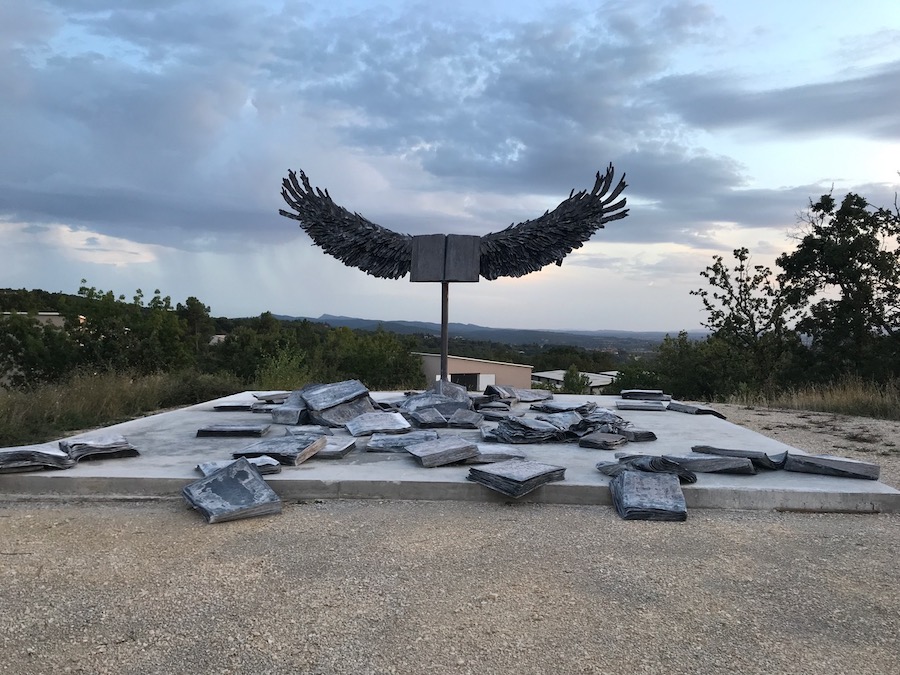
La Ribaute. Barjac. Anselm Kiefer. Photo: Elena Cué
My flight touched down in Marseille on a sunny September morning and although my ultimate destination was Barjac, I couldn't help but make a small detour to visit the Château La Coste vineyards, a magical symbiosis of architecture, sculpture and natural landscape in the south of France. The complex's curator Daniel Kennedy was waiting there to show me the collection. The Tadao Ando Art Centre is a building conceived with the artist's signature elements in mind: smooth concrete, lines that are simple, modern and in tune with the vestiges of Japanese tradition, water, the dominance of light and an architectural design in perfect harmony with its surroundings. Then there's the magnificent outdoor collection comprising projects by the likes of Louise Bourgeois, Richard Serra, Tracey Emin, Frank Ghery, Jean Nouvel and Jenny Holzer to name but a few, dotted all over the landscape.
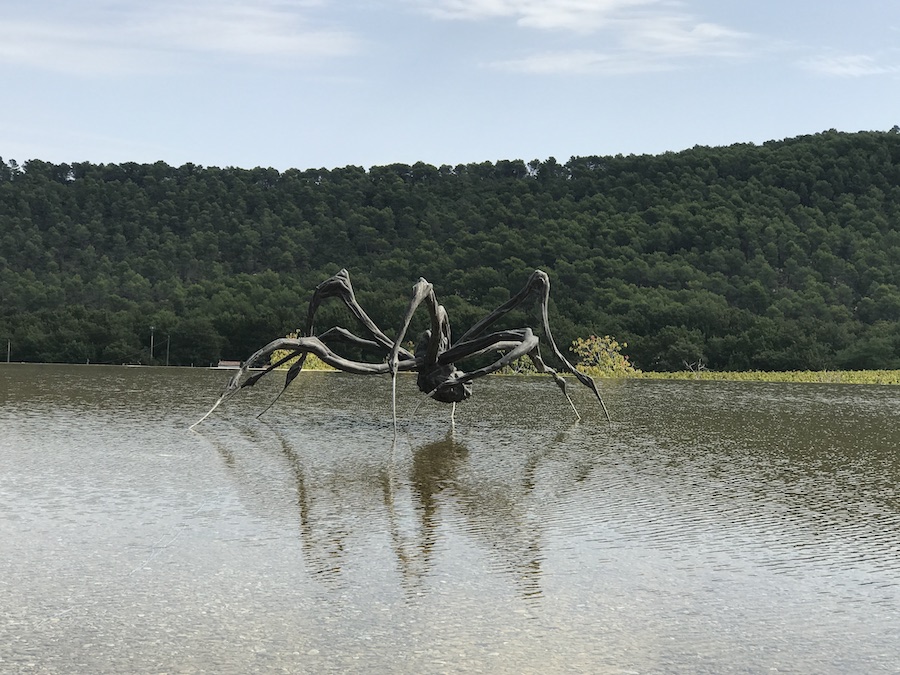
Maman. Louise Bourgeois. Château la Coste. Photo Elena Cué
But that's not why I came to Provence. The whole point of my trip was La Ribaute so I quickly made tracks for Barjac, my goal. And what or who was it about this little town that had attracted me there? Well, none other than a certain Teuton, his legend and his very personal cosmology. This is a 200 acre estate containing over 60 massive barns, pavilions and greenhouses brimming with Anselm Kiefer's work all inter-connected via subterranean tunnels with caves, grottos, bridges, crypts and an amphitheatre. He has planted trees and vegetation, he has built trails, walls and fences. The La Ribaute project was begun and developed from the abstract idea of a vacuum. A vacuum that had to be filled.
Anselm Kiefer moved to Barjac in 1992 where he found, albeit with some reservations, the ideal space to build his own personal creative paradise. On one of the esplanades in these 40 hectare grounds stands a crown of his iconic and enigmatic towers: "The Seven Heavenly Palaces" that reference the mystic, Hebrew narrative of our celestial ascension by means of the gradual loss of our material bodies and spiritual elevation until we reach the final palace where only our souls remain forever. These apocalyptic towers symbolise the notion of creation and destruction that so characterises the work of the artist, who tells me: "I destroy whatever I make all the time. Then I store the broken bits in containers and wait for their resurrection."
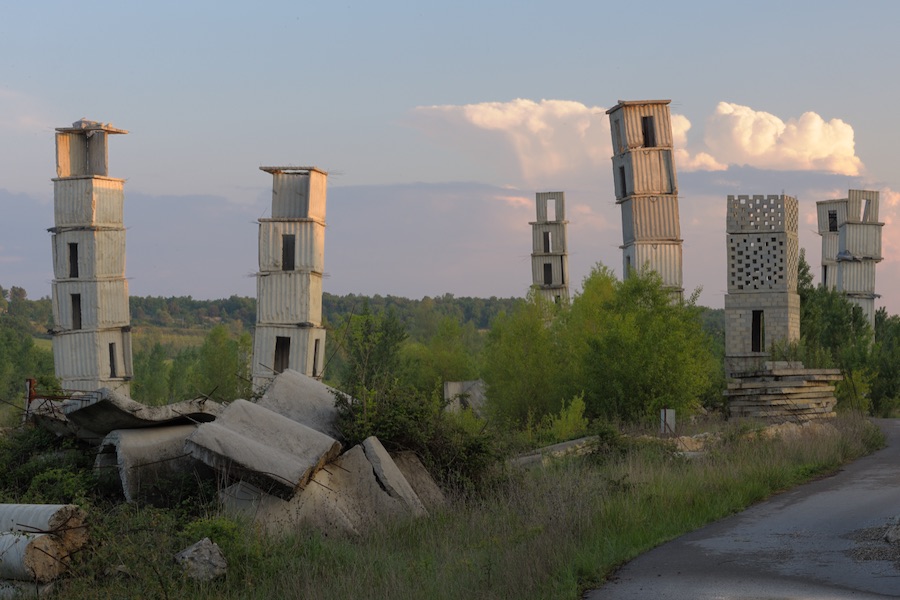
The Seven Heavenly Palaces. Photo: Charles Duprat. (c) Anselm Kiefer
This amazing artistic complex has hardly ever been visited, not yet being open to the public, and my tour of it was a succession of unique sensations, beginning at dusk as I made my way to the old silk factory where Anselm Kiefer and his trusty assistant Waltreaud were waiting for me. His face tanned, his eyes lively and intense, his smile inviting me to embark on our visit, we set off for the nearby buildings. We walked along paths lined with flora typical of the region and along which were placed sculptures of his characteristic lead books, symbolic of knowledge, strewn over or piled up on large blocks of stone, almost as if at any moment a sorcerer might emerge from the depths of the forest in some feat of alchemy.
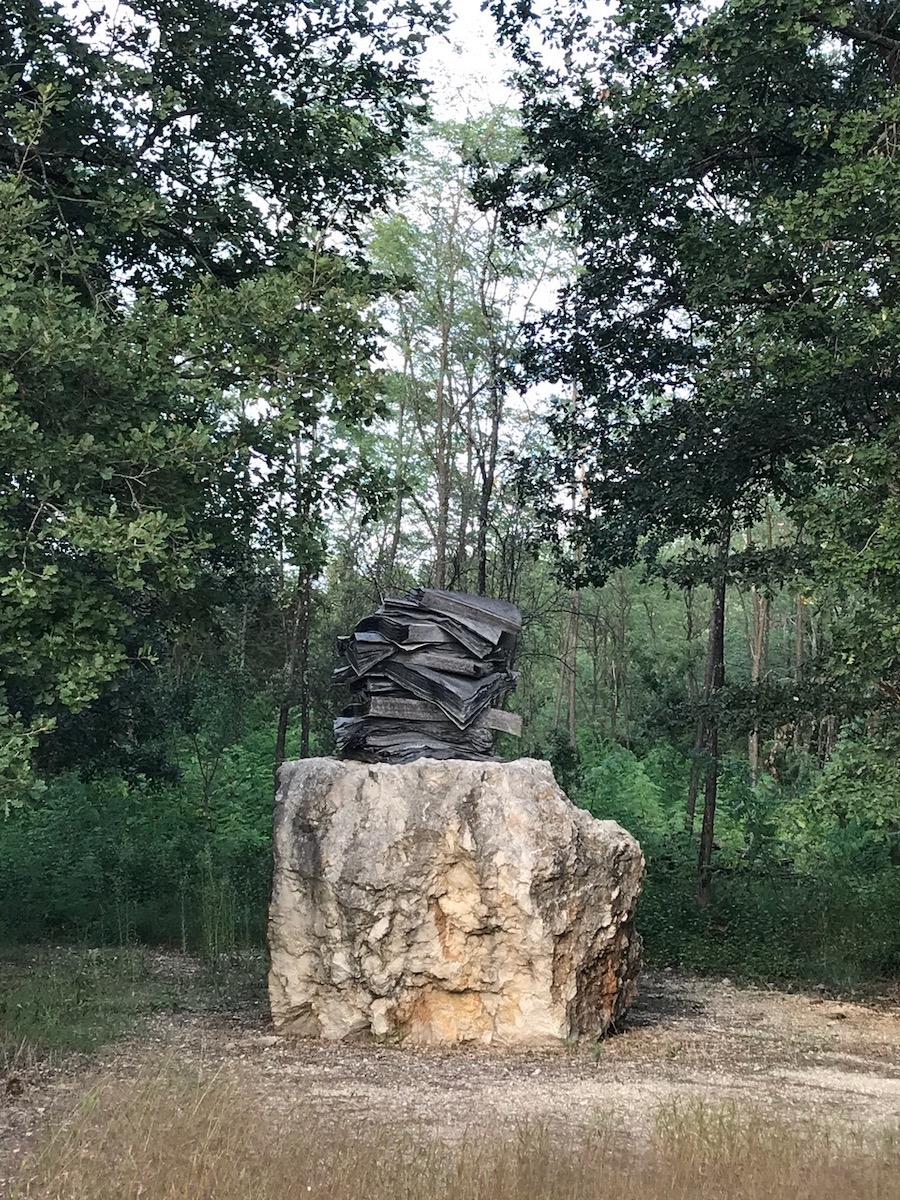
Anselm Kiefer. Barjac. Photo: Elena Cué
What first impacts me is a greenhouse topped with a World War II-like airplane made of lead with dried sunflowers spouting from it. Kiefer cultivates them here from Japanse seeds that grow to seven metres high. As if in a laboratory, he also cultivates tulips and other plants he will later use as materials for his work. These spaces devoted exclusively to one piece are the ones that resonate the most. We continue on to the next pavilions housing installations, paintings and sculptures all with the Holocaust as their theme. Kiefer's childhood was marked by a silence around what had happened: "When I was young, the Holocaust didn't exist. Nobody spoke about it in the 60's." He could feel there was something missing, something hidden and when he found out what it was, Kiefer tells me: "I was so affected by Hitler I started studying the Holocaust. I wanted to know what it was all about. What happened at that time is so horrible it's hard to imagine it." This would become a vital theme in his work.
In 1945, in the Black Forest, in the city of Donaueschingen where the two sources of the river Danube converge, Anselm Kiefer, one of the most prominant artists of our time, was born into a devastated Germany. While his mother was giving birth in the basement of a hospital, the family home was being blown to pieces by Allied bombs. The son of a Wehrmacht official, his childhood was marked by the authoritarianism of his father and a strict Catholic education.
Growing up in the ruins of a Germany that was destroyed and anxious to erase its tragic past awakened a profound interest in Kiefer to get to know about Judaism and the event that embodied archetypal evil - the genocide committed by Nazis. That catastrophe, so infinite, so boundless in its terror, so impossible to imagine let alone depict was to become the central strand in Kiefer's aesthetic and ethics.
Barely an hour later, I returned to the main house. In a huge, white, rectangular room of grandiose dimensions, the emptiness was only filled by one white linen sofa, some curtains hiding a bed at one end and an industrial kitchen with a large table of rustic wood at the other. I immediately joined the others for a supper that went on for five hours. Kiefer talked about the sensation he gets on seeing his paintings in retrospect, namely, a certain perception of his work as never being finished. As an aside, he mentioned how difficult it was to transport his "The Morgenthau Plan" from La Ribaute. This installation, housed in one of the pavilions, is the metaphorical conceptualization of the proposal masterminded shortly before the end of WWII by the US Secretary of the Treasury, Henry Morgenthau. The plan consisted of the elimination of Germany's industries and its subsequent transformation into an agricultural country. In it, Kiefer explores that would-be rural landscape: the resurgence of flowers from the devastation before. He considered it to be pure propaganda: "You know, all they did was help Hitler with this plan. They calculated that between 10 and 15 million Germans would die of hunger. And Roosevelt didn't want this. Hitler listened to Goebbels and, as far as they were concerned, it was a godsend; they would have the perfect excuse to maintain the German state by warning its citizens about what would happen if they didn't fight on. Not long ago, I also saw something about the Marshall Plan and that was all propaganda, too. Did you know that?"
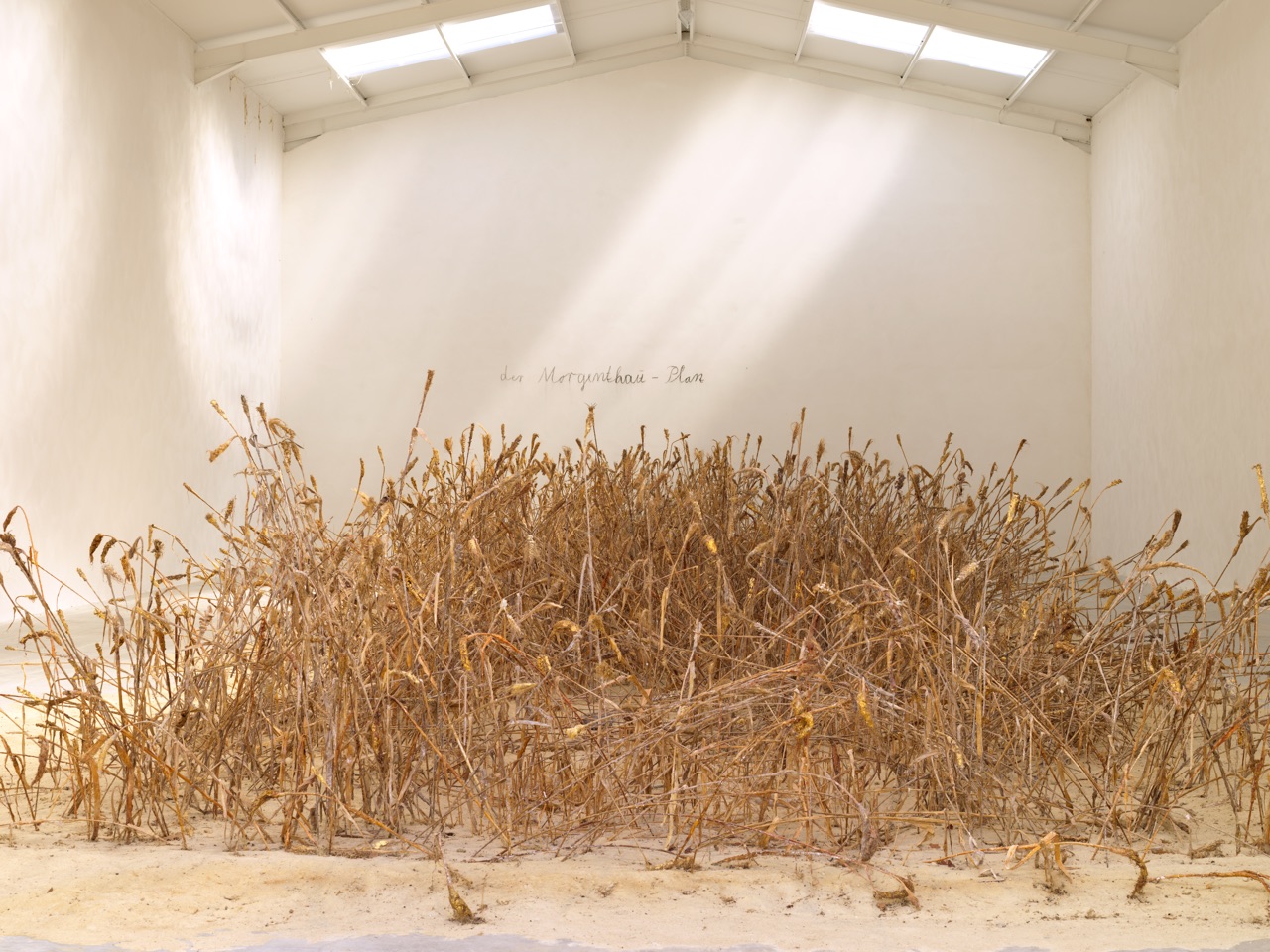
The Morgenthau Plan. Barjac. Anselm Kiefer. Photo: Charles Duprat. (c) Anselm Kiefer
The conversation went on so long that it got very late and I was invited to stay the night. The room, as with the rest of the building, was huge and somewhat intimidating as much for its dimensions as for the austerity of its minimalist decor. The following morning, we went to have a look at a series of the catacombs that are connected to each other like the creeping roots of a rhizome and to the pavilions above them at ground level. Before going underground, we went into the amphitheatre, which is the centrepiece of La Ribaute, as the artist was telling me: "The amphitheatre came about the same way a painting would. I had a large wall where I hung all my large paintings and I just thought, why not make a little grotto inside? So, I got hold of some containers and covered them with liquid cement and put them all together. The aim was just to have a little alcove in that big wall. Then, we continued with another layer on top, and another, etc and it kept on working out like a drawing. I've no idea how it will end up ...". This construction, 15 metres high, consists of different installations in each of the rooms within the containers. In one of them, there are reels of film, made out of strips of lead, hanging from the ceiling and featuring photographs taken by the artist thirty years ago.
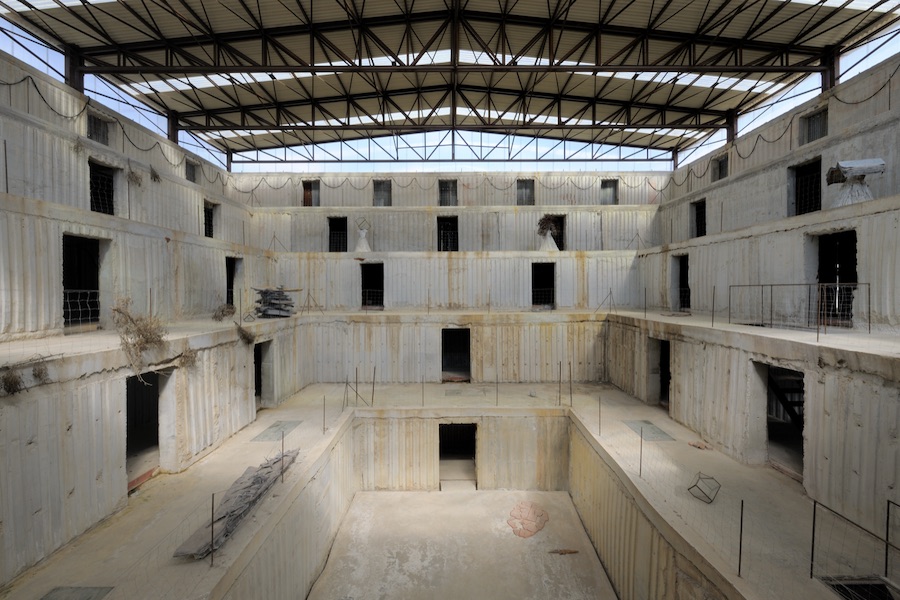
Amphitheatre. Barjac. Anselm Kiefer. Photo: Charles Duprat. (c) Anselm Kiefer
From there, we took an underground route that was somewhat reminiscent of a stone Gruyère cheese and I was immediately stopped in my tracks. Accessed by a narrow cave, we had come face to face with a deeply disturbing room, its walls lined with lead, the floor deep in water and a single light bulb hanging from a cable attached to the ceiling. Kiefer told me this was the first ever room he had completed and asked me, out of curiosity, what I thought of the acoustics. I answered that I hadn't experienced any sound at all. I'd been stunned into silence by what I saw.
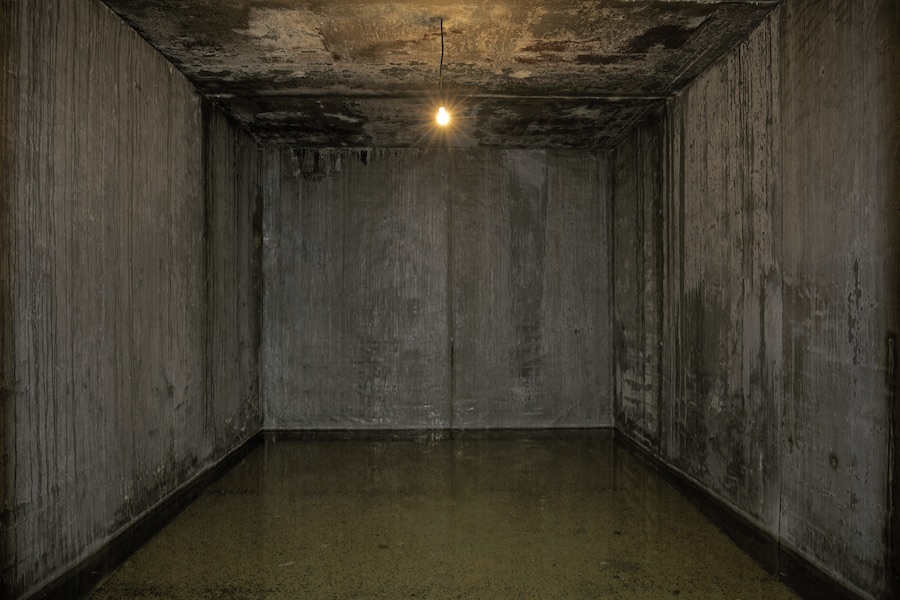
Lead Room. Anselm Kiefer. Photo: Charles Duprat. (c) Anselm Kiefer
As we make our way through the grottos, our perceptions change continually, the artist disappears and we are transported to other times, other places. Through these subterranean passages, we are able to travel to the Palaeolithic age, to the tragedies of Ancient Greece, to the time of Christ and to Auschwitz. And so we arrive at another impactful room: "The Women of the Revolution", sixteen beds with puddles of stagnant water on their rumpled, lead sheets giving the impression of skin or leather. This was the dividing line between the female interior and exterior that the artist uses as a metaphor for the immense inner power of women faced with the bravado of men. The highlight of the room is on the wall opposite - a lead panel picturing Kiefer with his back to us, in a landscape that very much reminded me of the German Romantic painter Caspar David Friedrich's "Wanderer Above A Sea Of Fog". It brought to mind the Kantian concept of the sublime and the inability of our imagination to grasp something so inestimable and so totally exceptional.
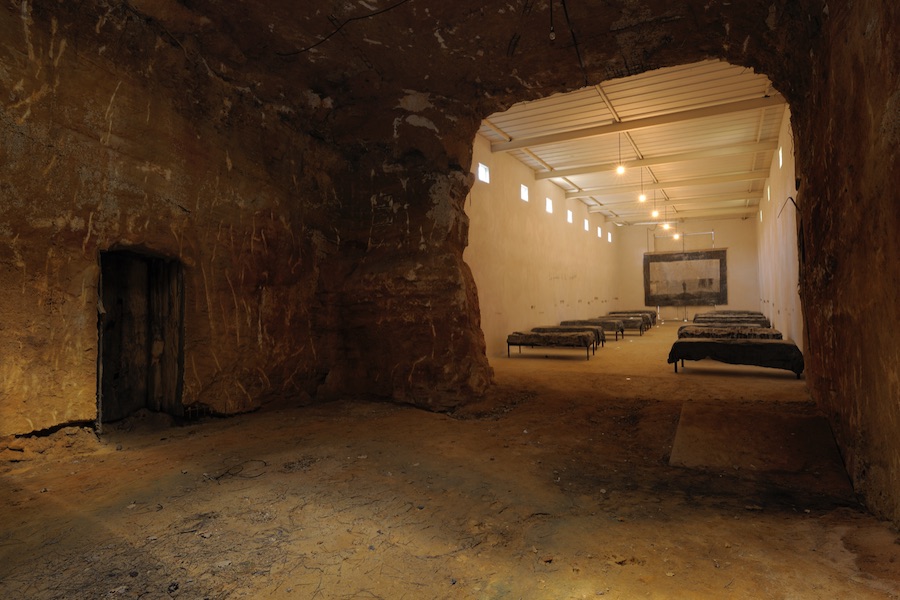
The Women Of The Revolution. Anselm Kiefer. Photo: Charles Duprat. (c) Anselm Kiefer
The tour over, I returned, even more staggered by the experience than before, to the main house to interview Kiefer. We talked at length over lunch during which time I discovered Kiefer's interest in science. He spoke with great admiration of the Spanish scientist Luis Alvarez-Gaume and his light particle teleportations to distances of tens of thousands of kilometres. "It's called teleportation. It happened to me and my grandmother. We used to think the exact same thoughts at the exact same time."
And we remembered Kant: "Every mention of the sublime has within it more enchantment than the phantasmagoric charms of the beautiful."
(Translated from the Spanish by Shauna Devlin)
- In the grotto of the Teuton. Anselm Kiefer in Barjac - - Alejandra de Argos -



